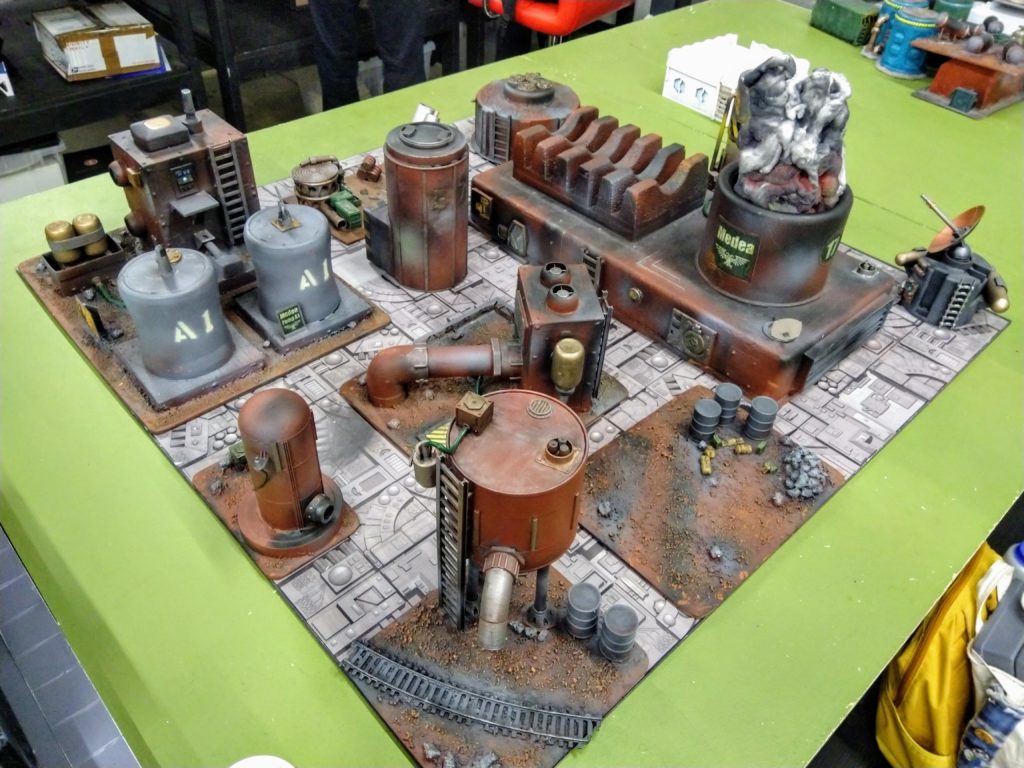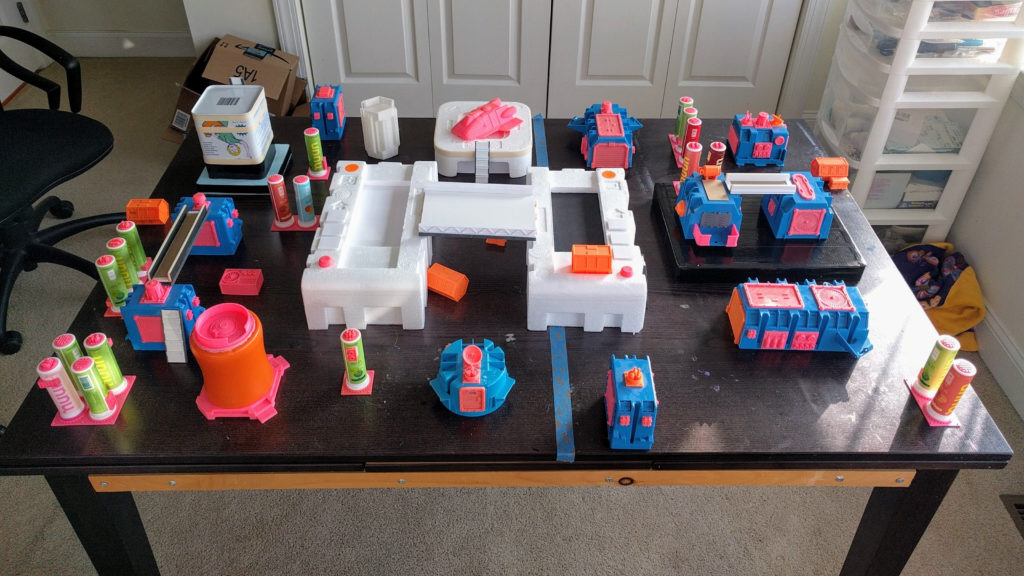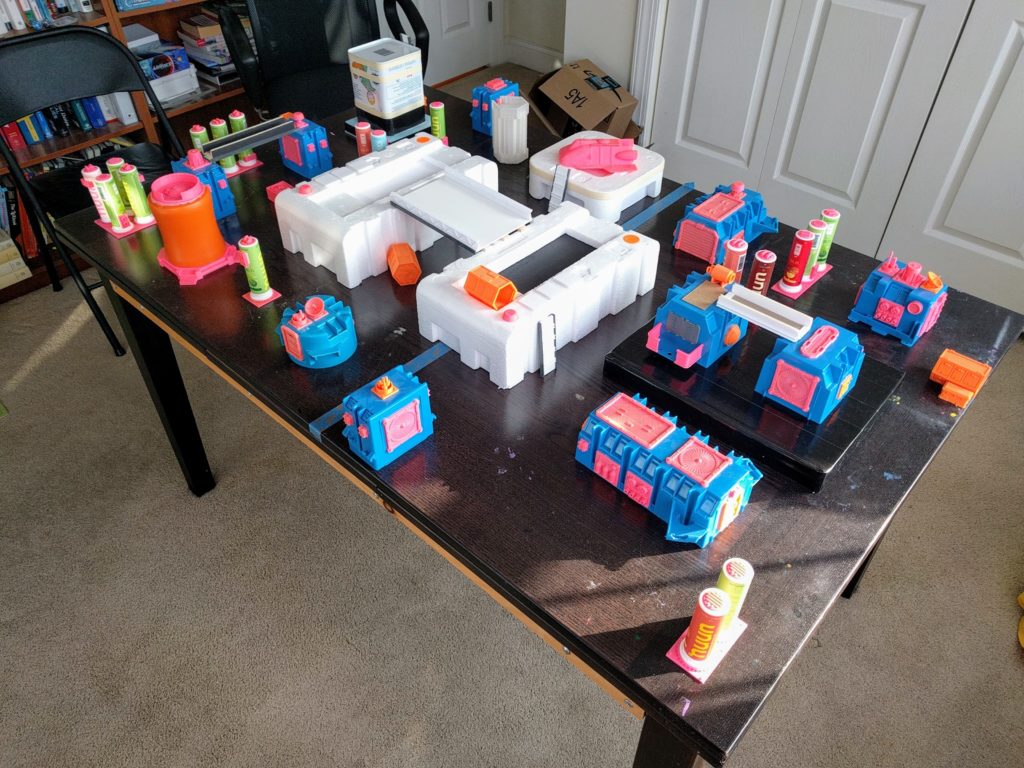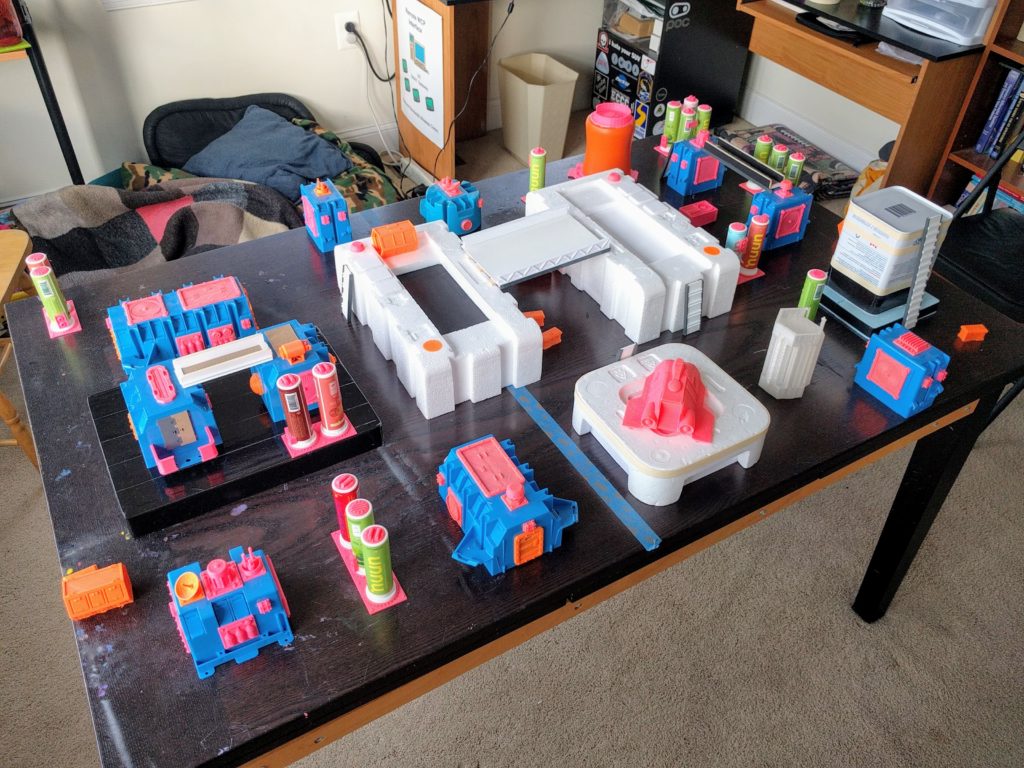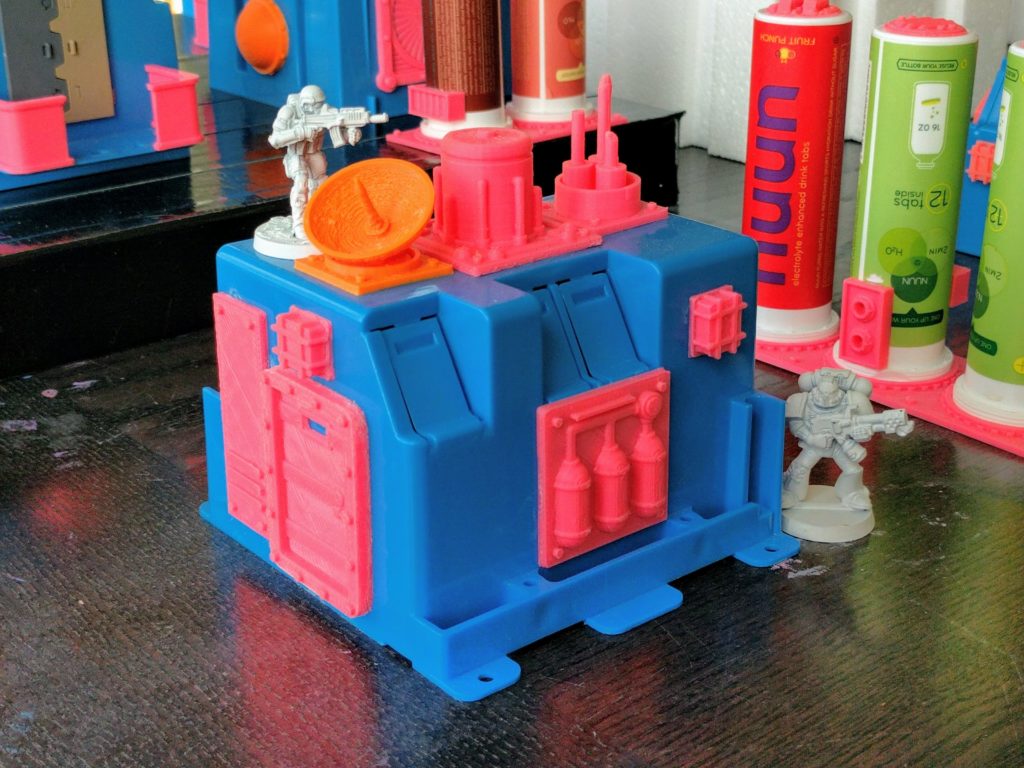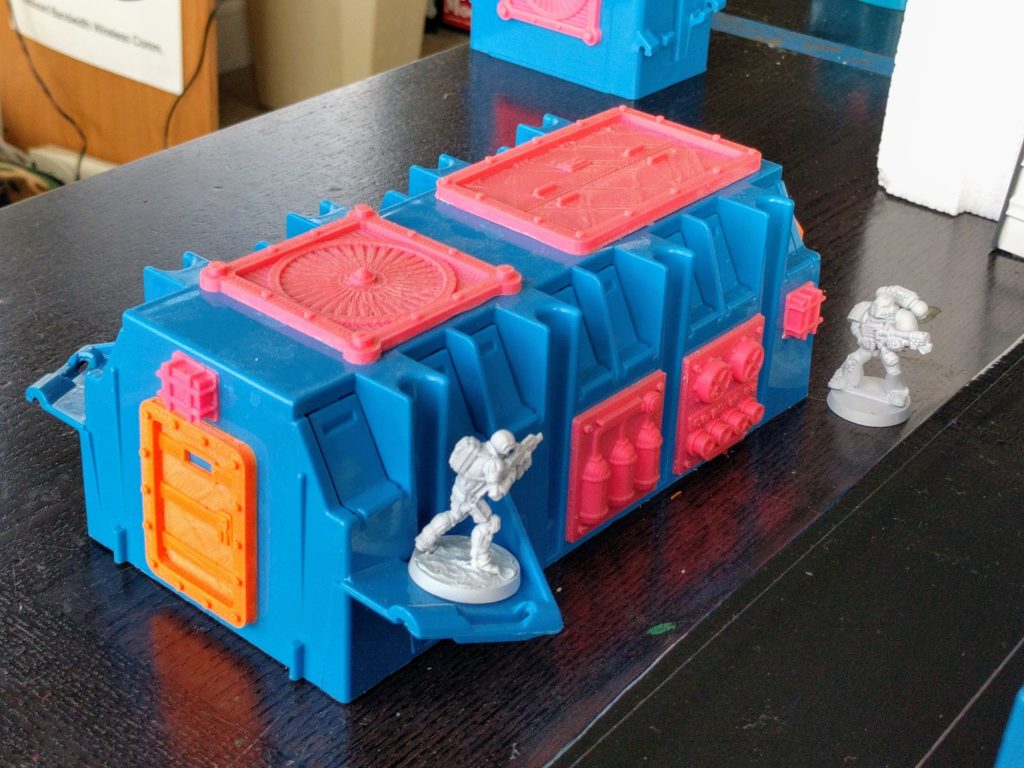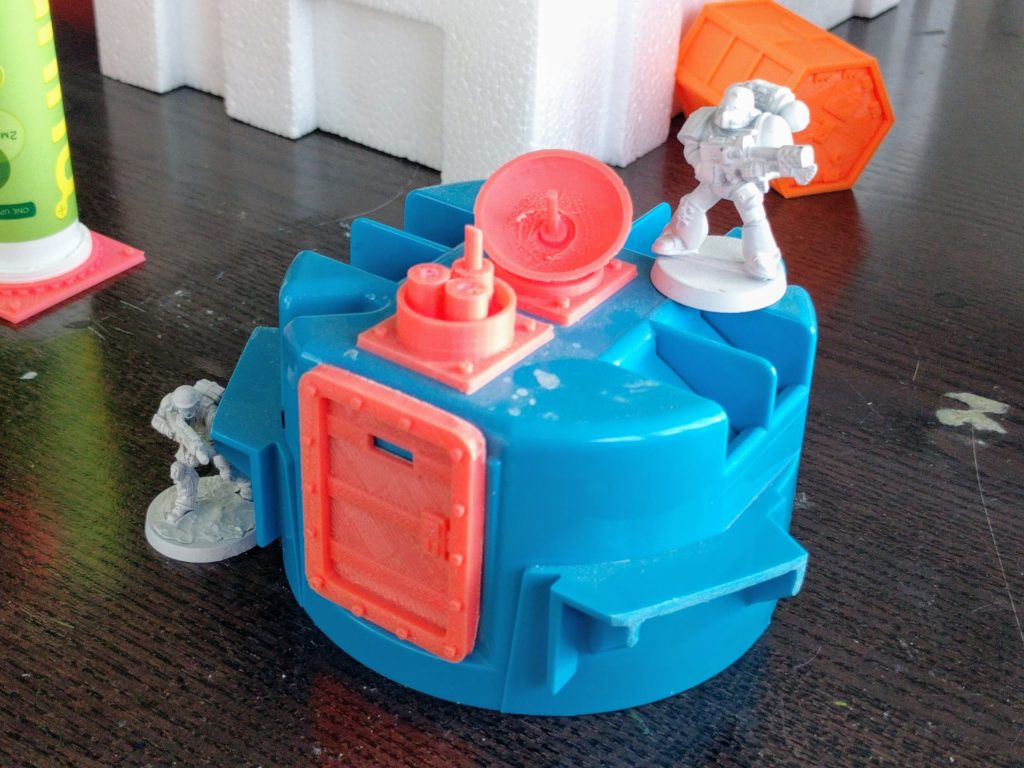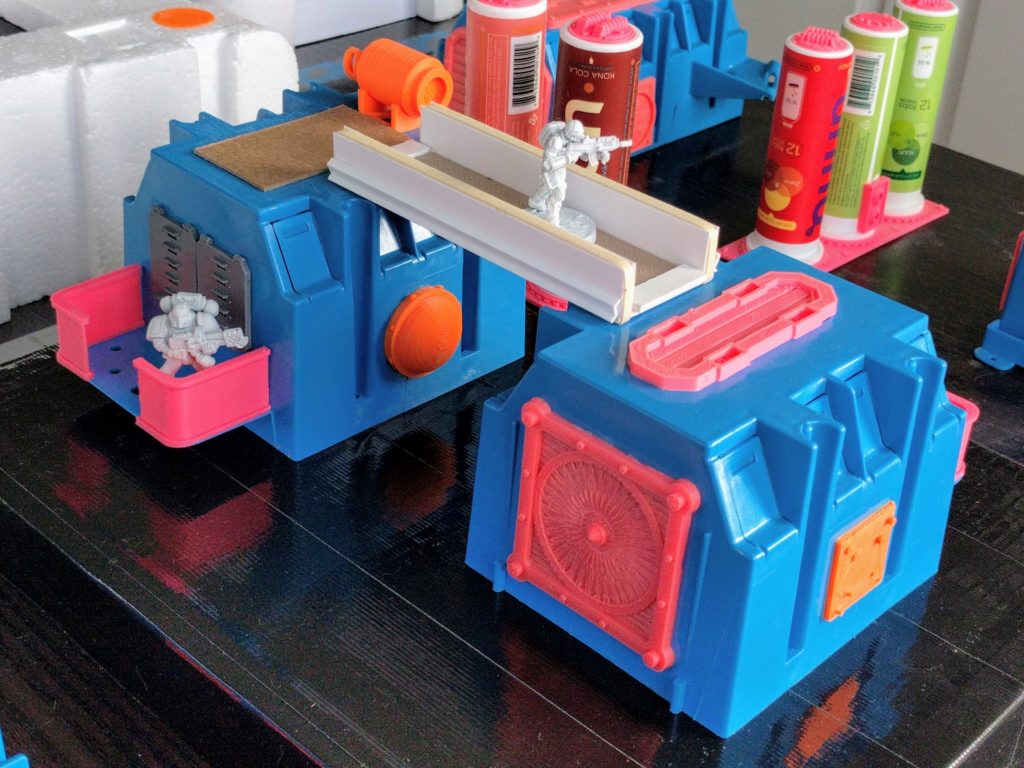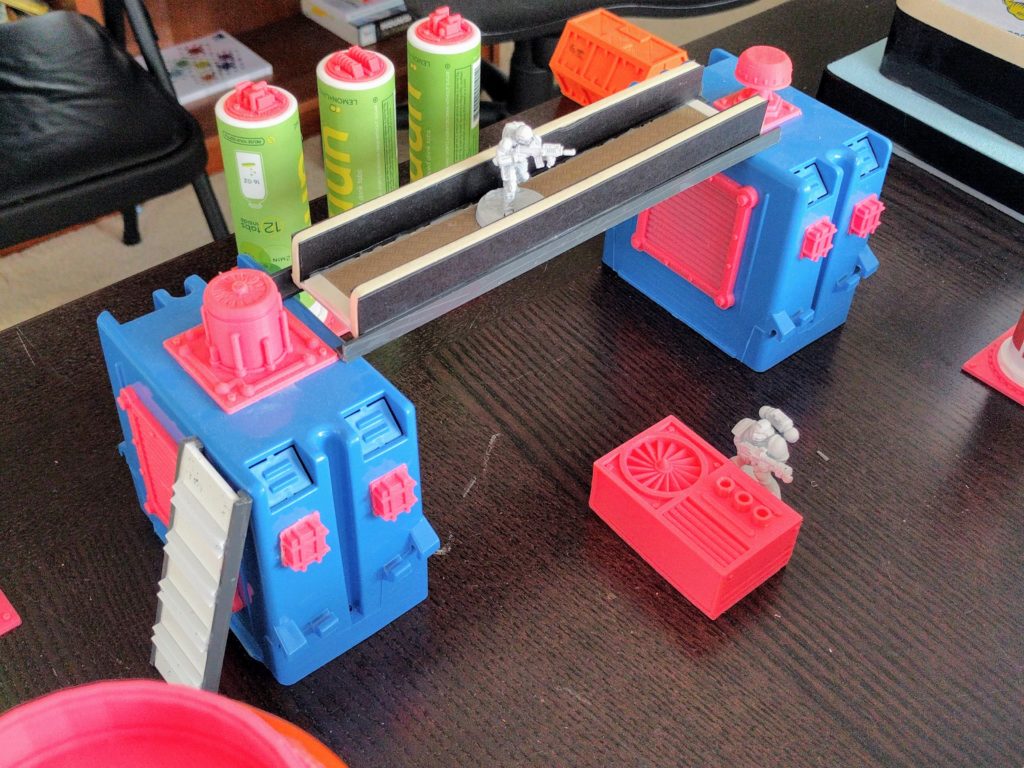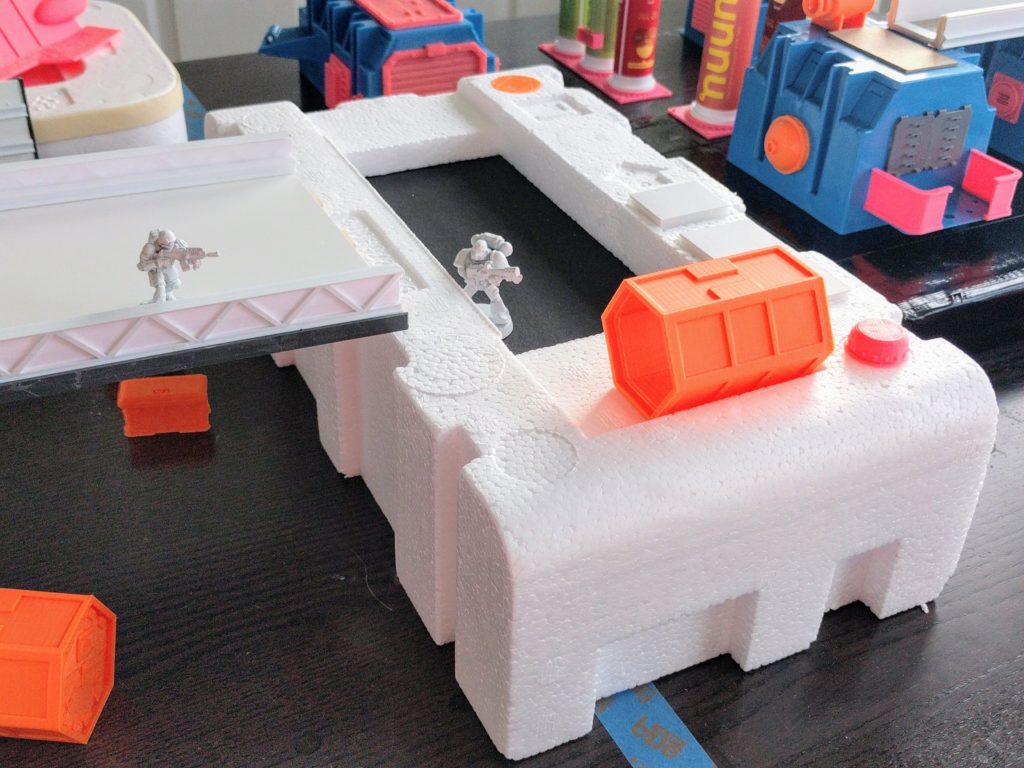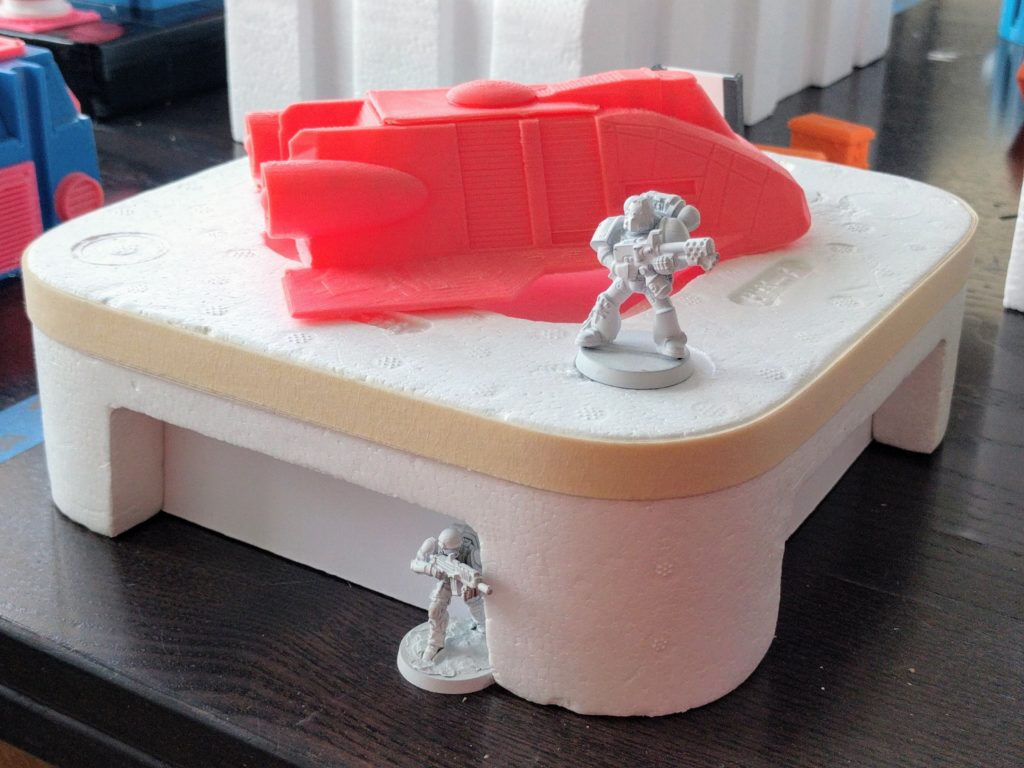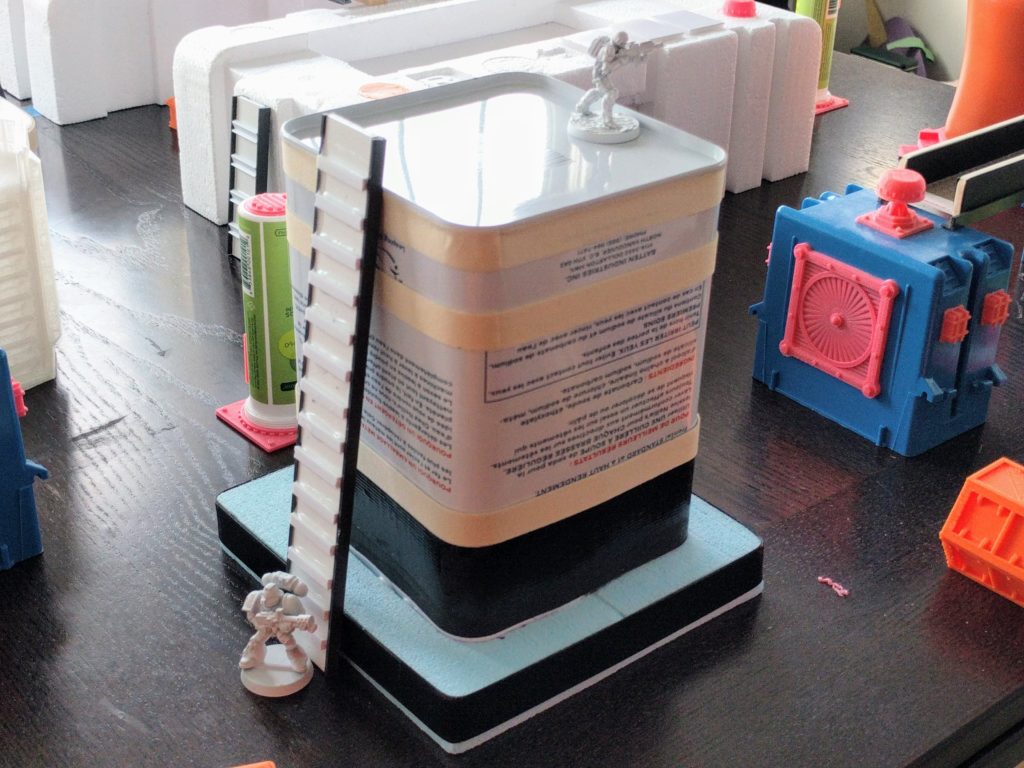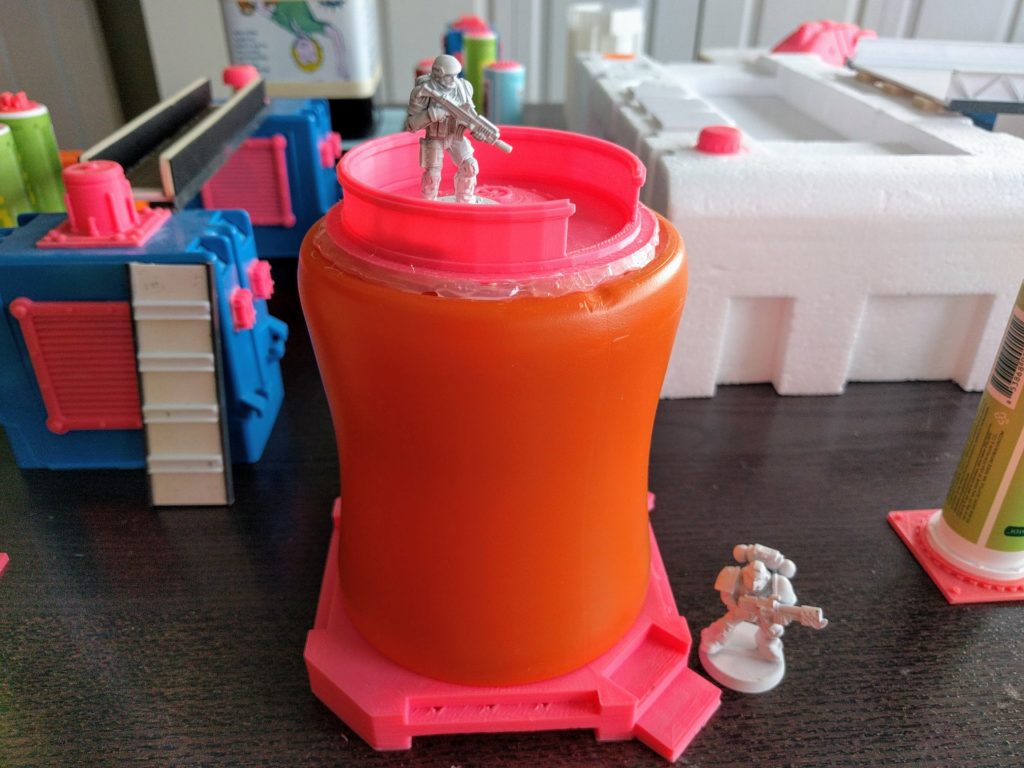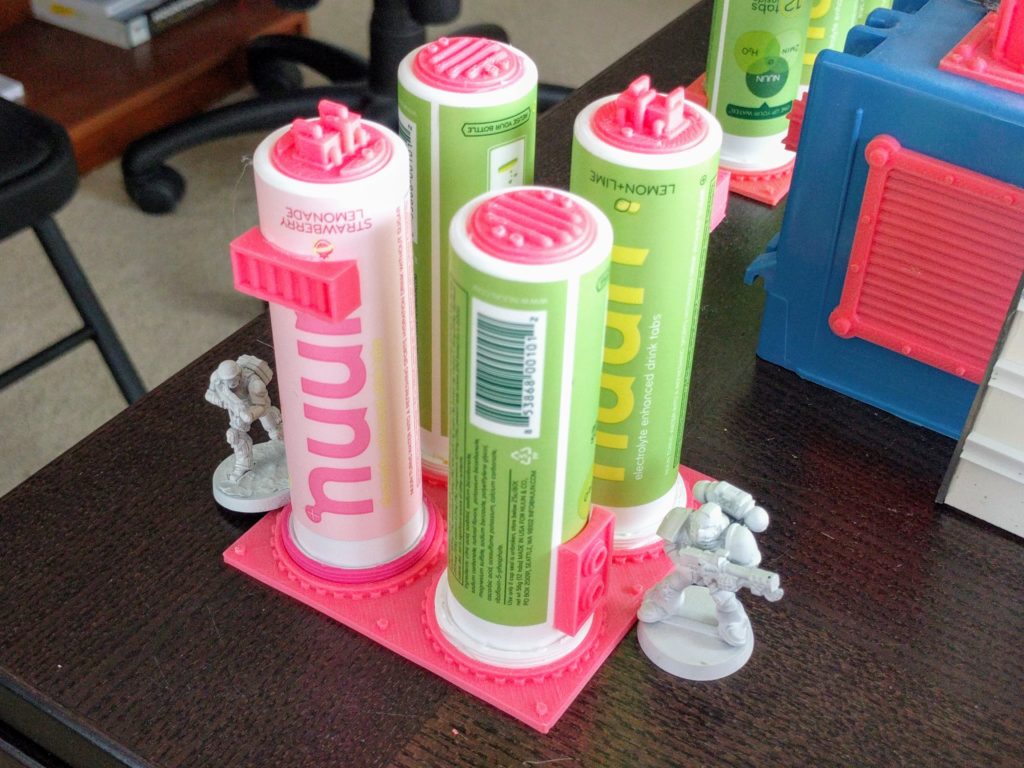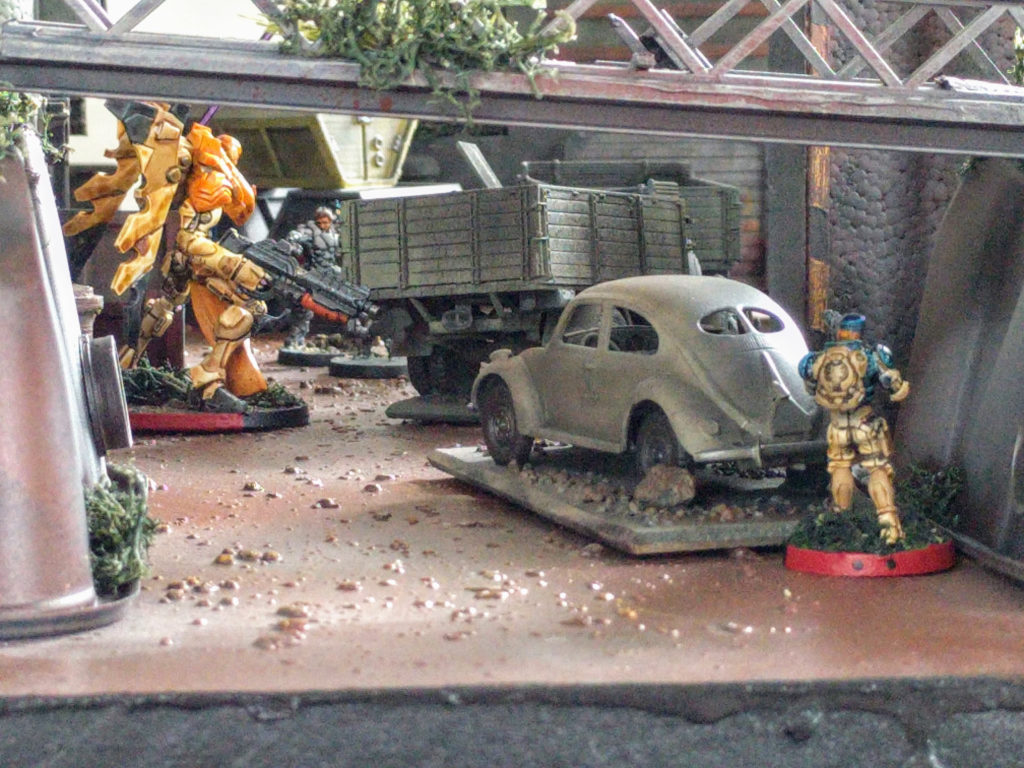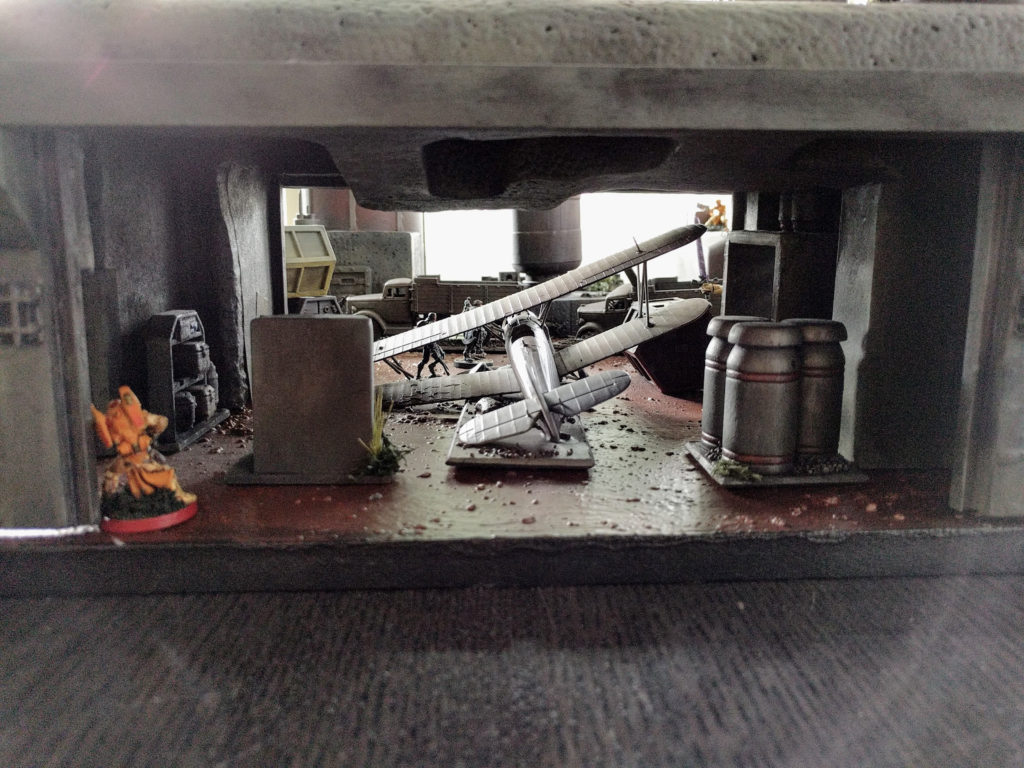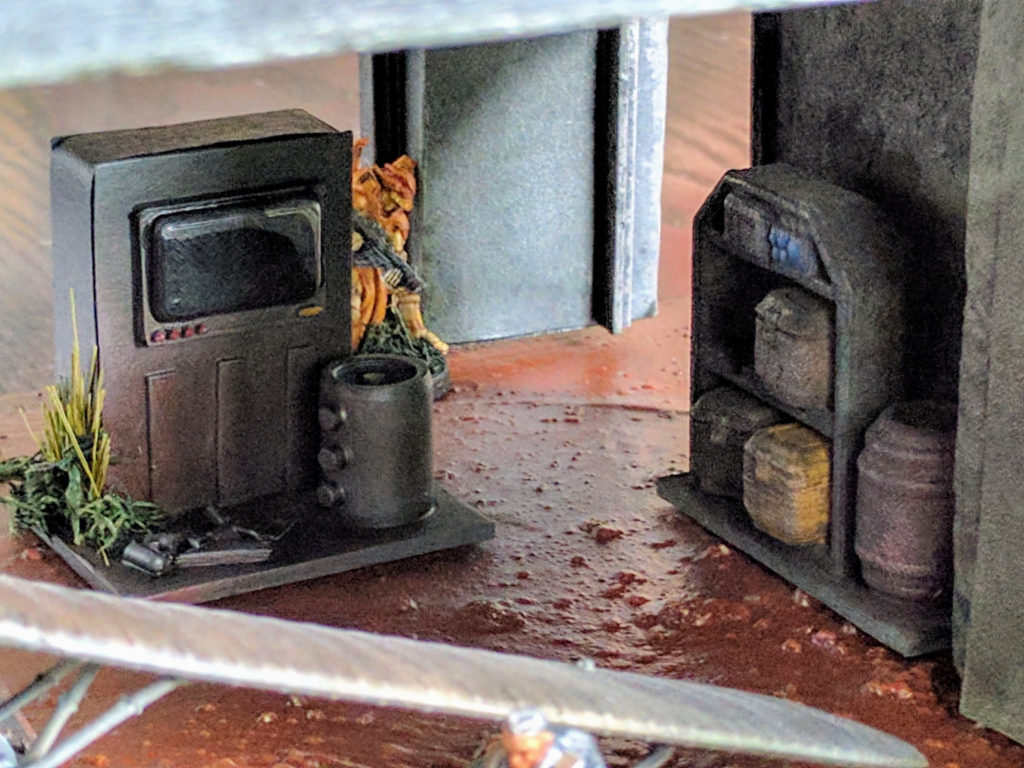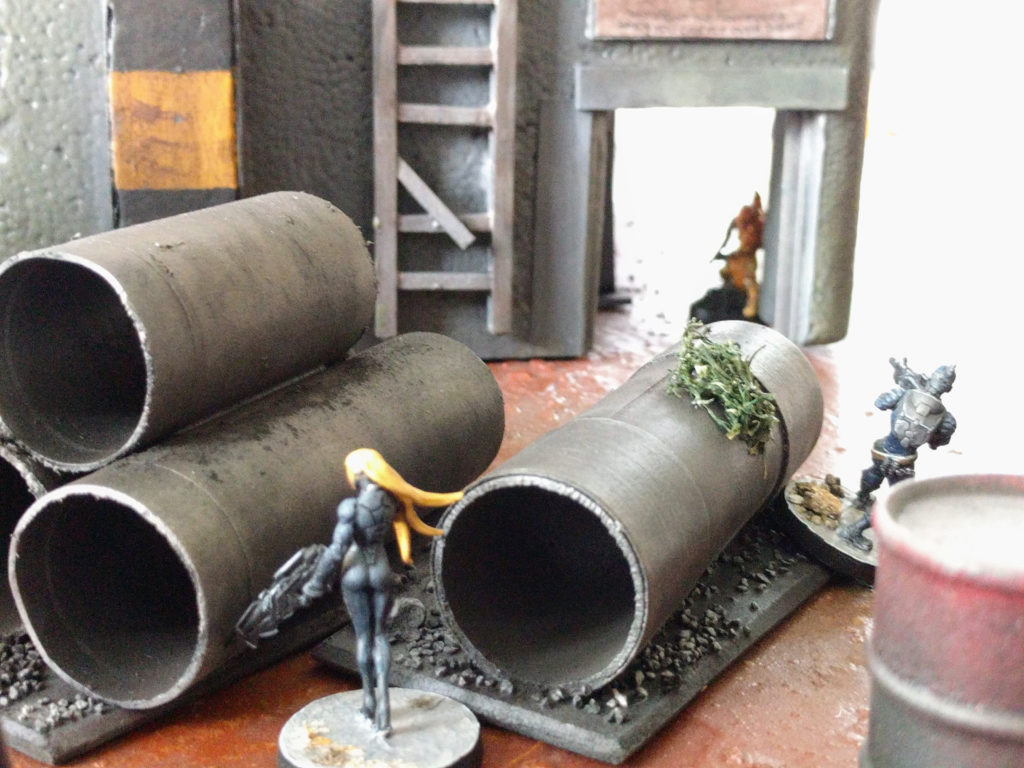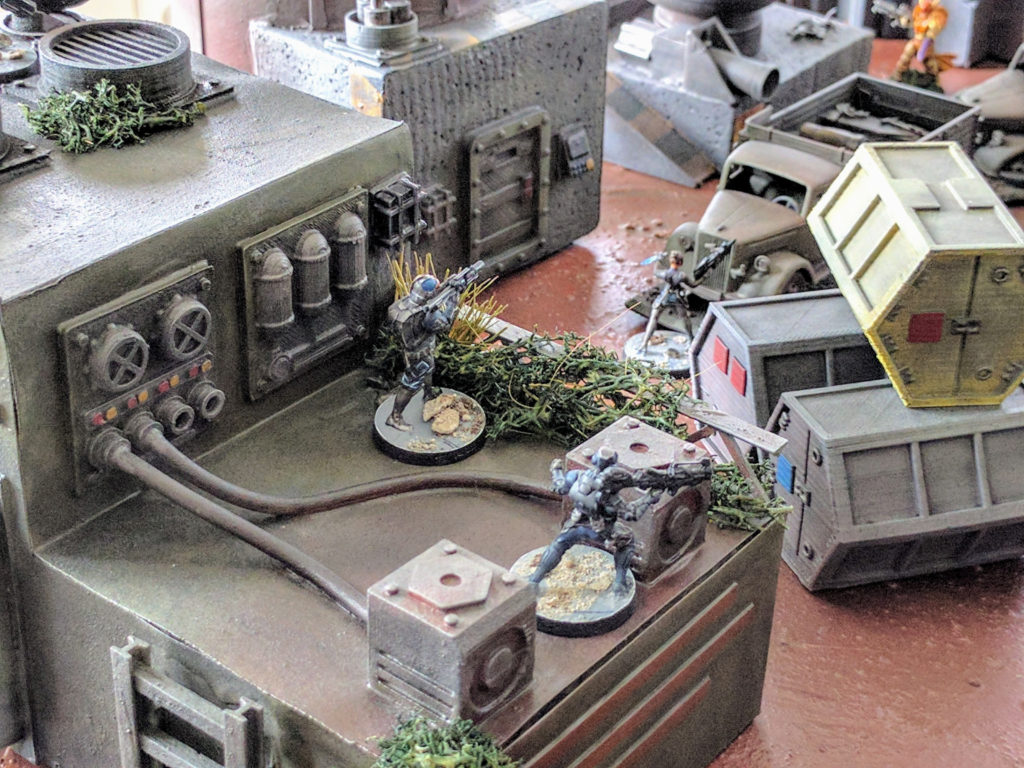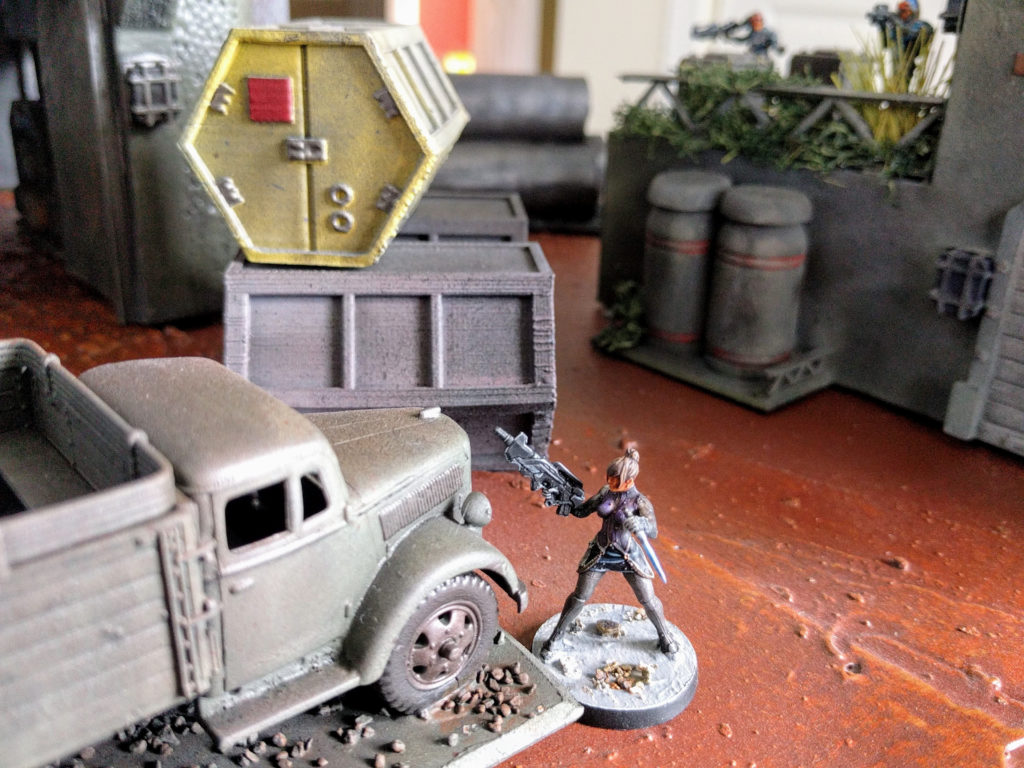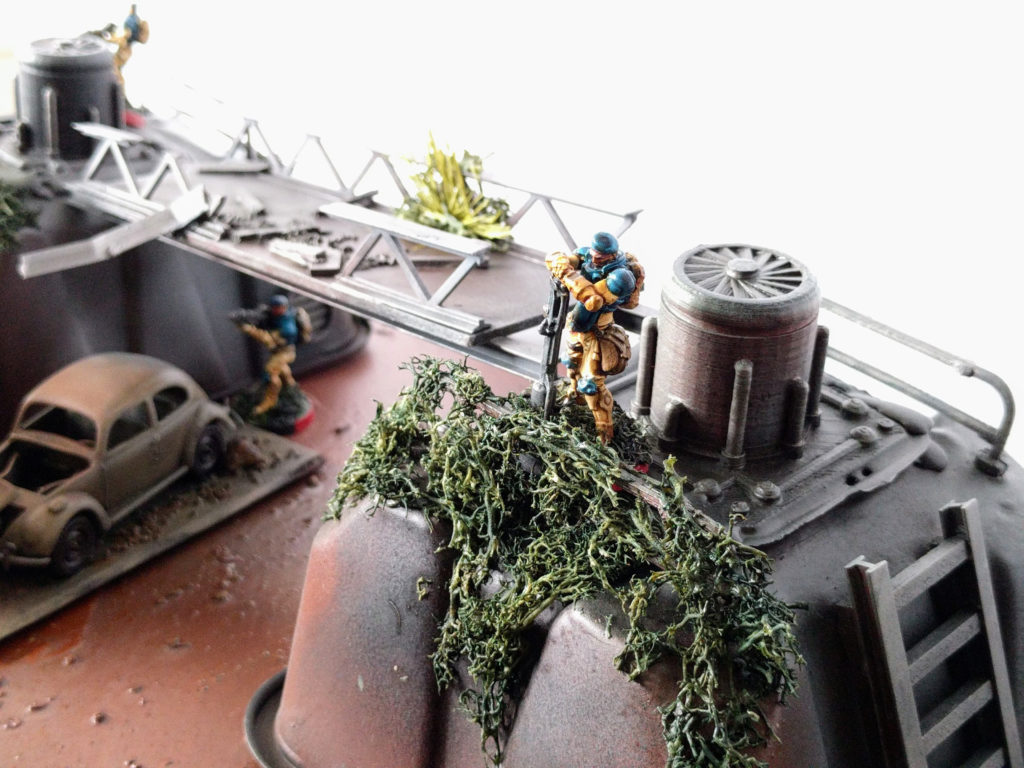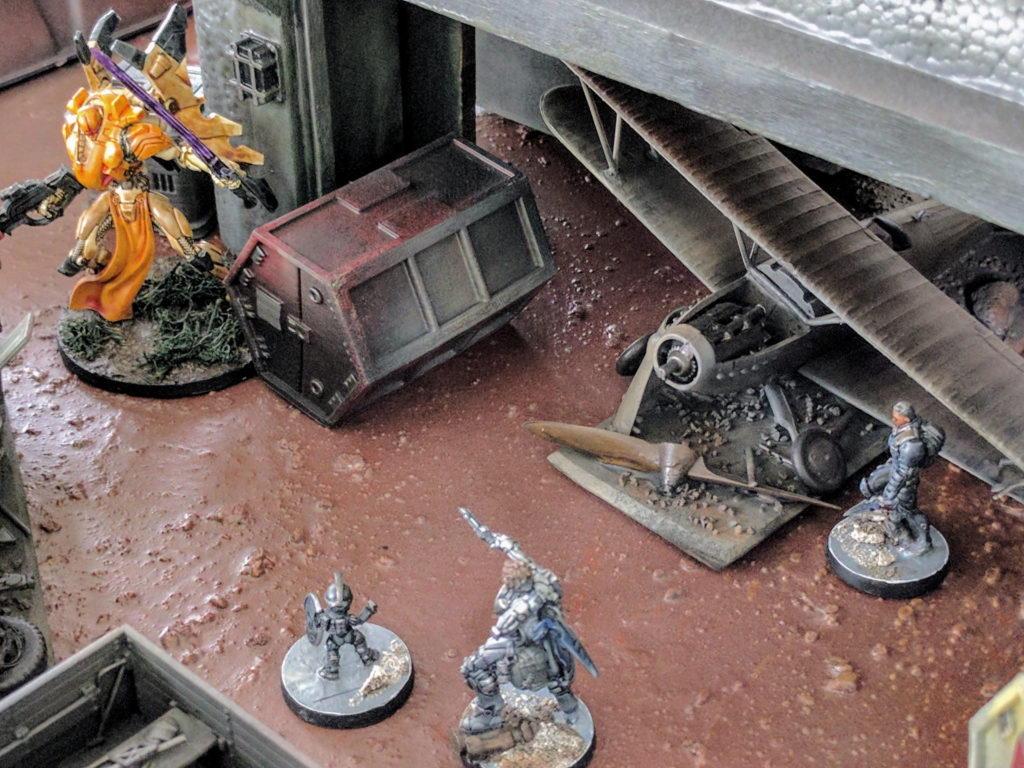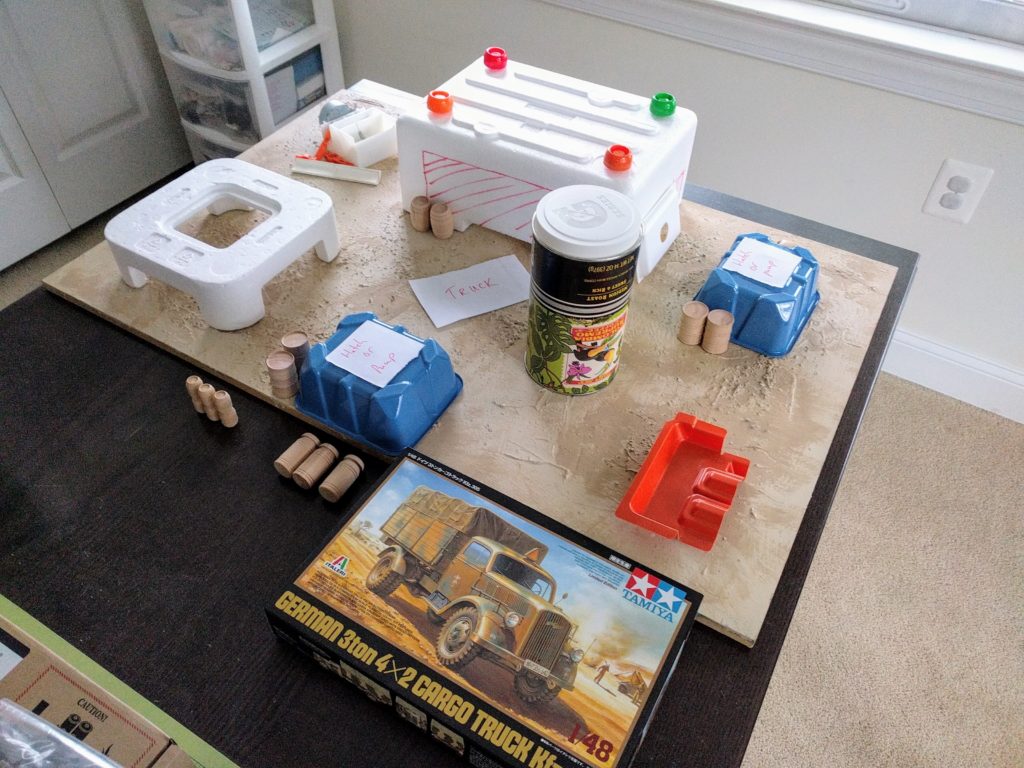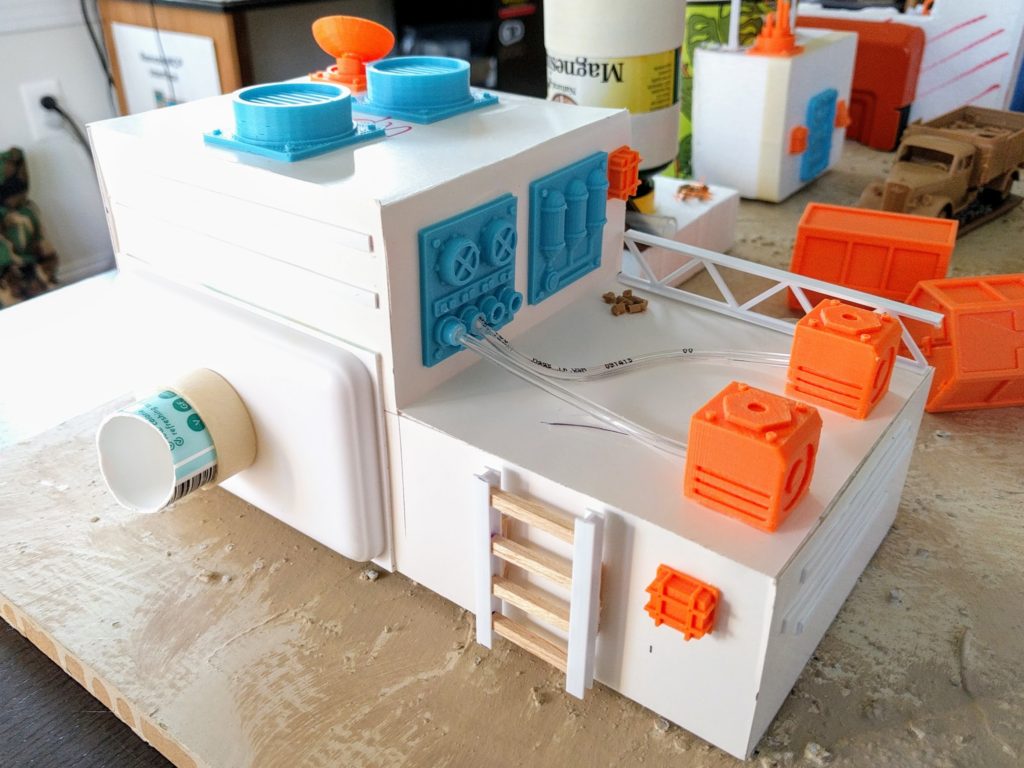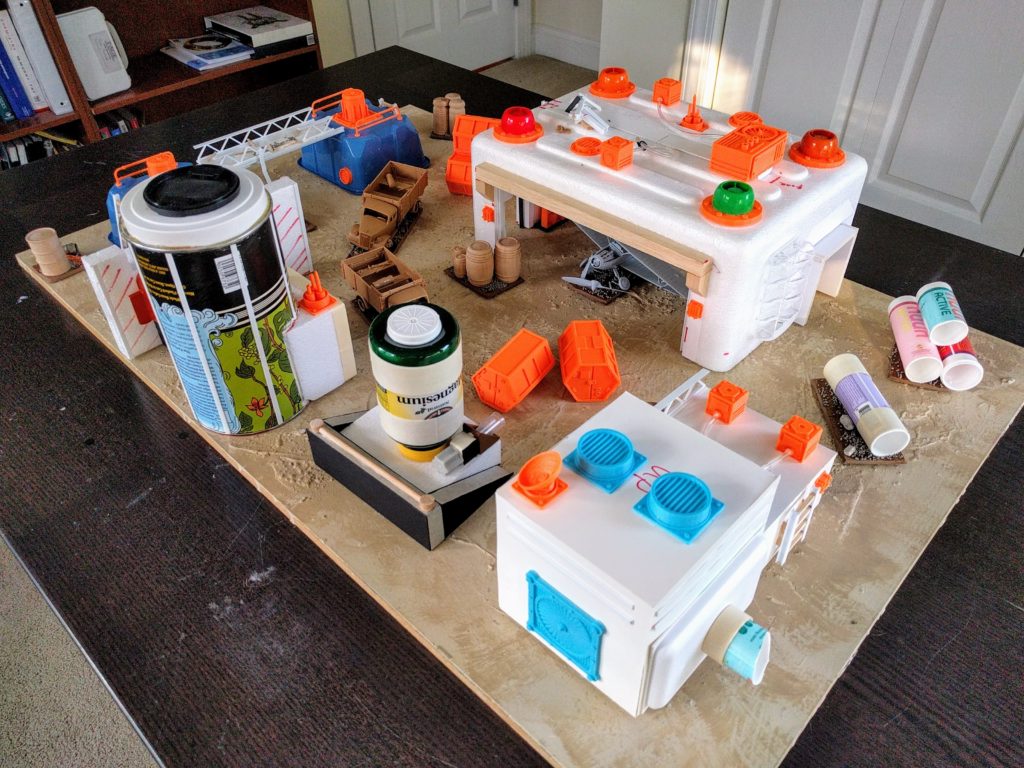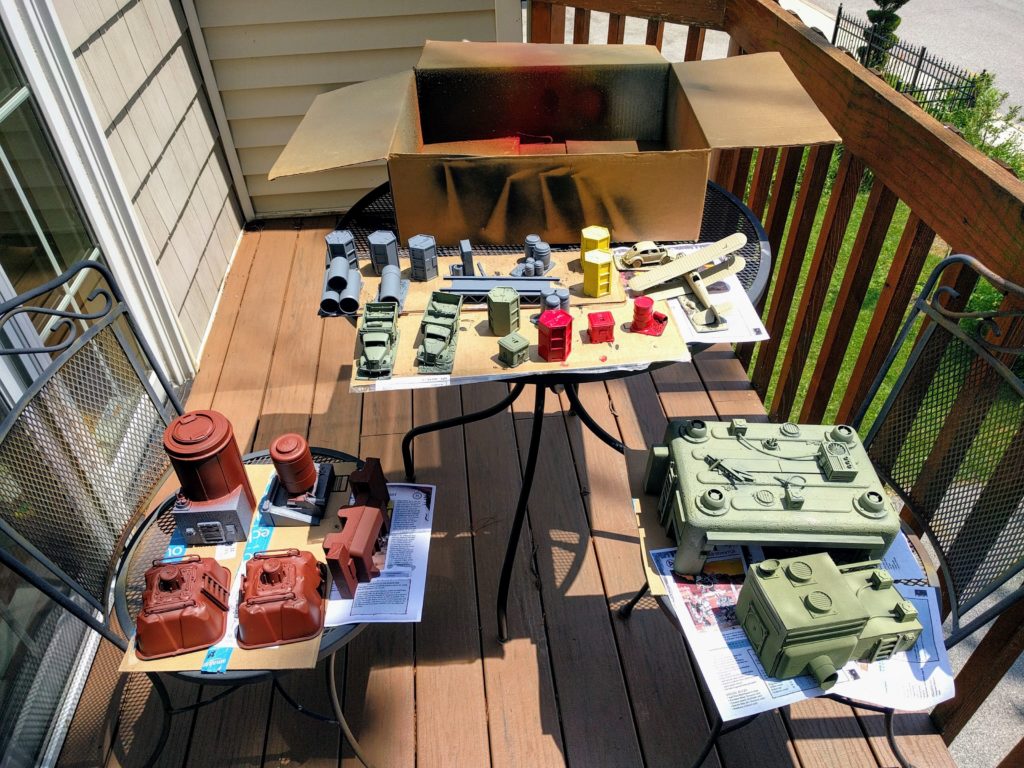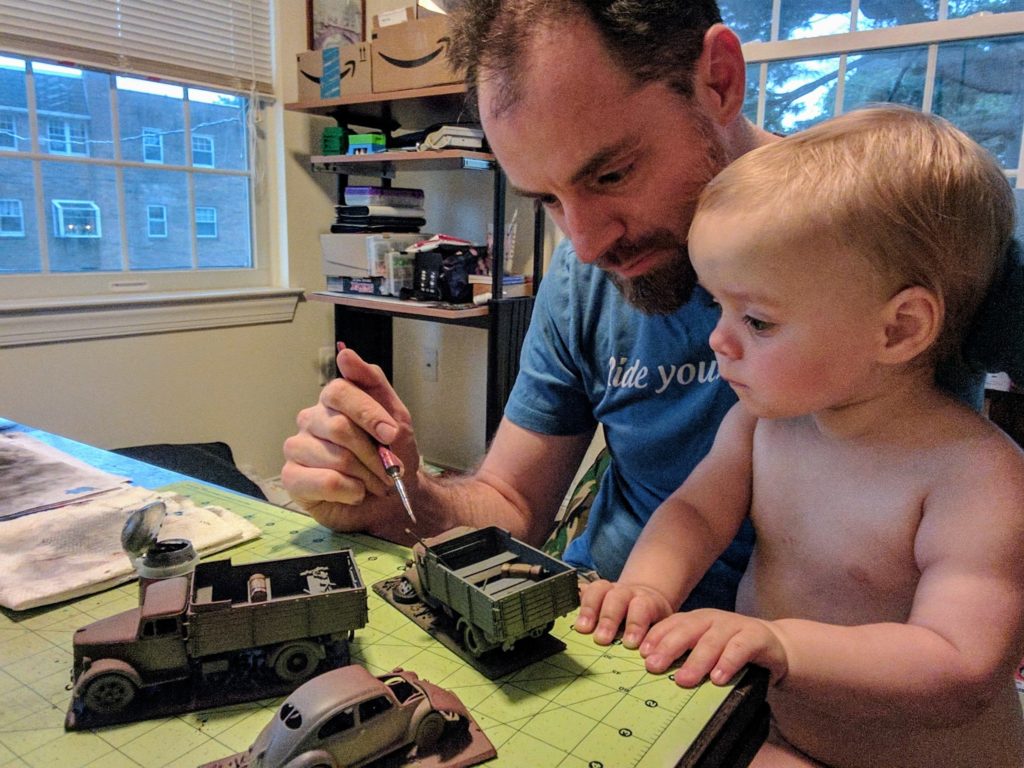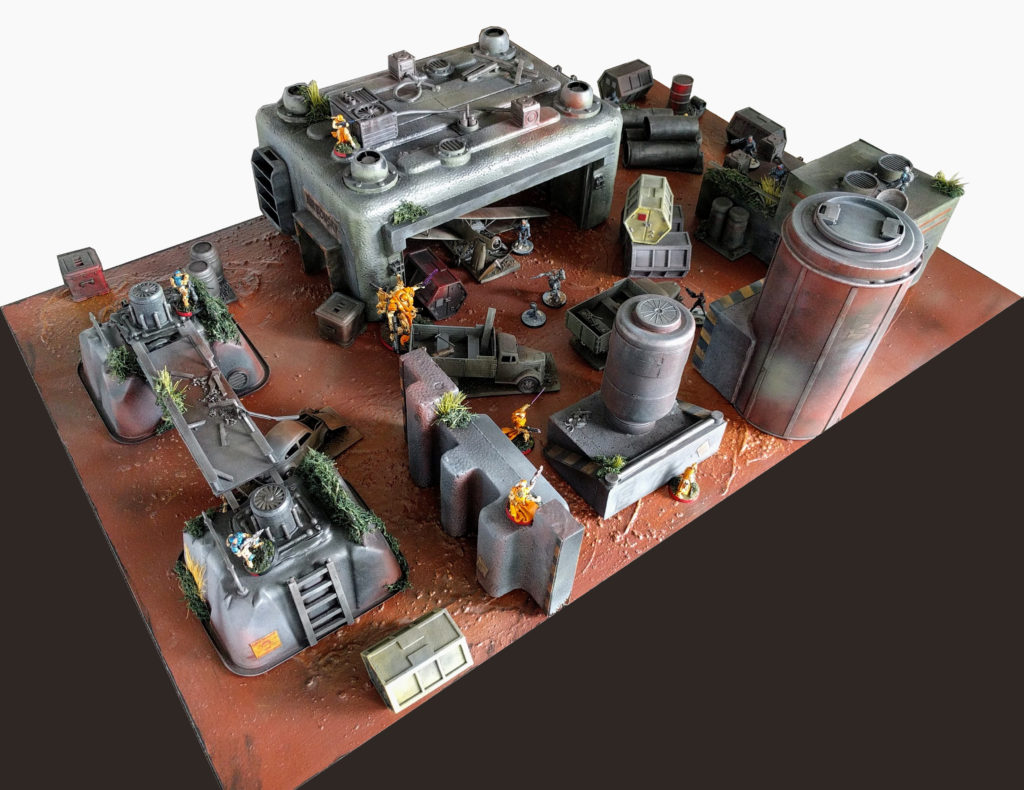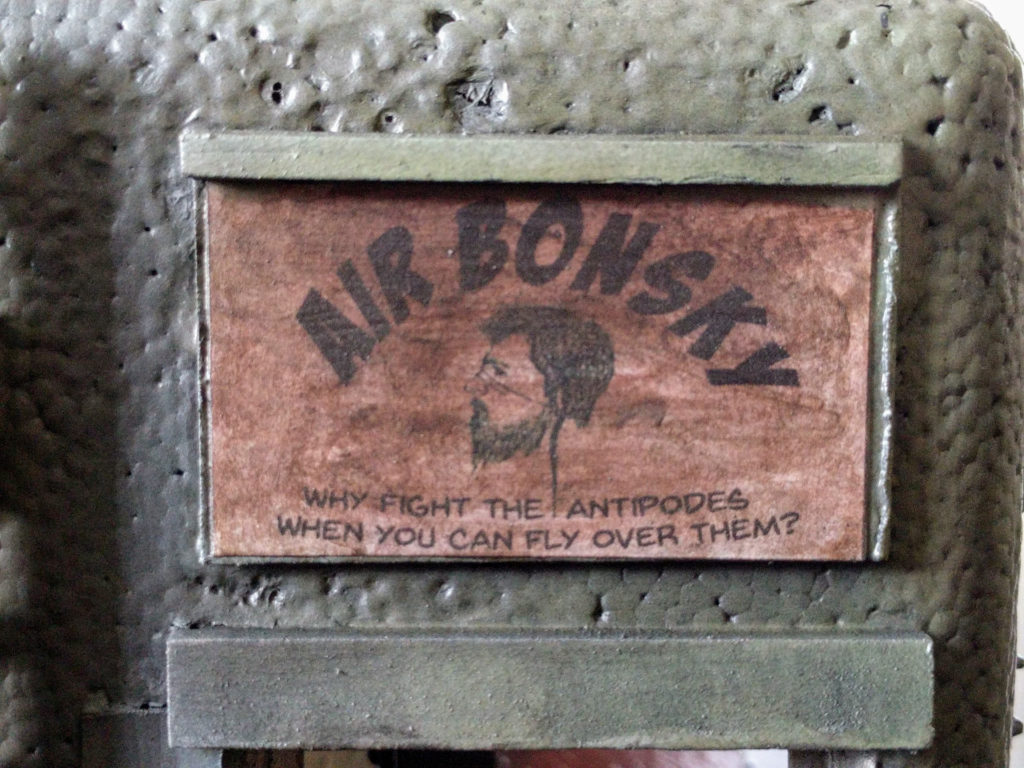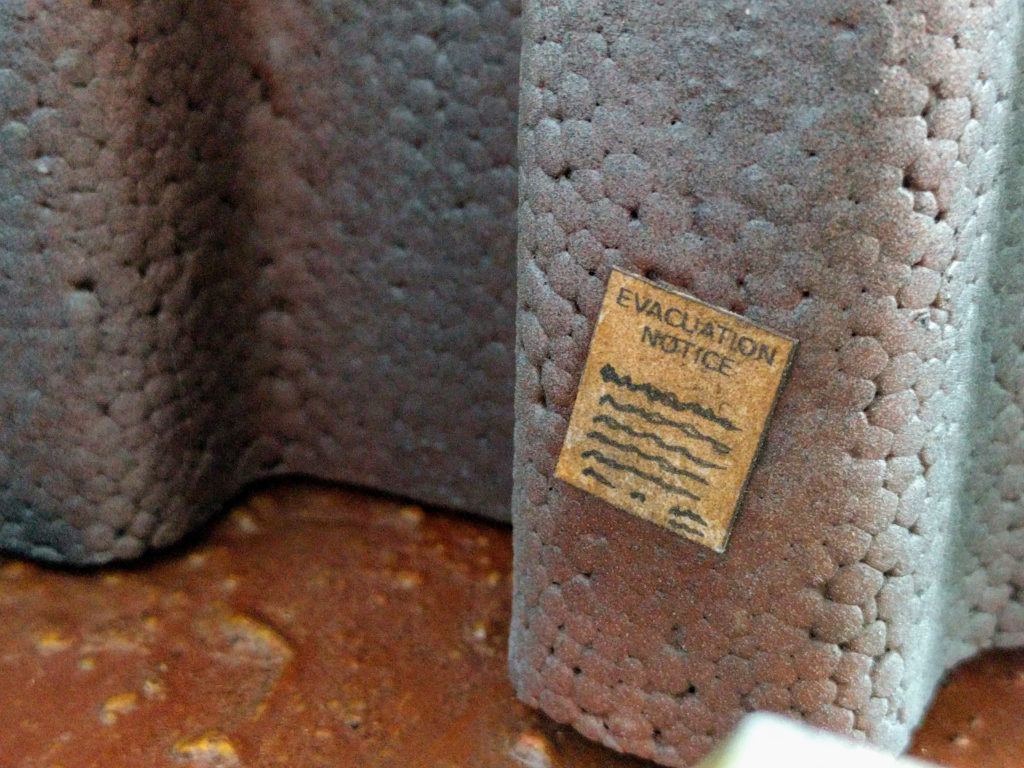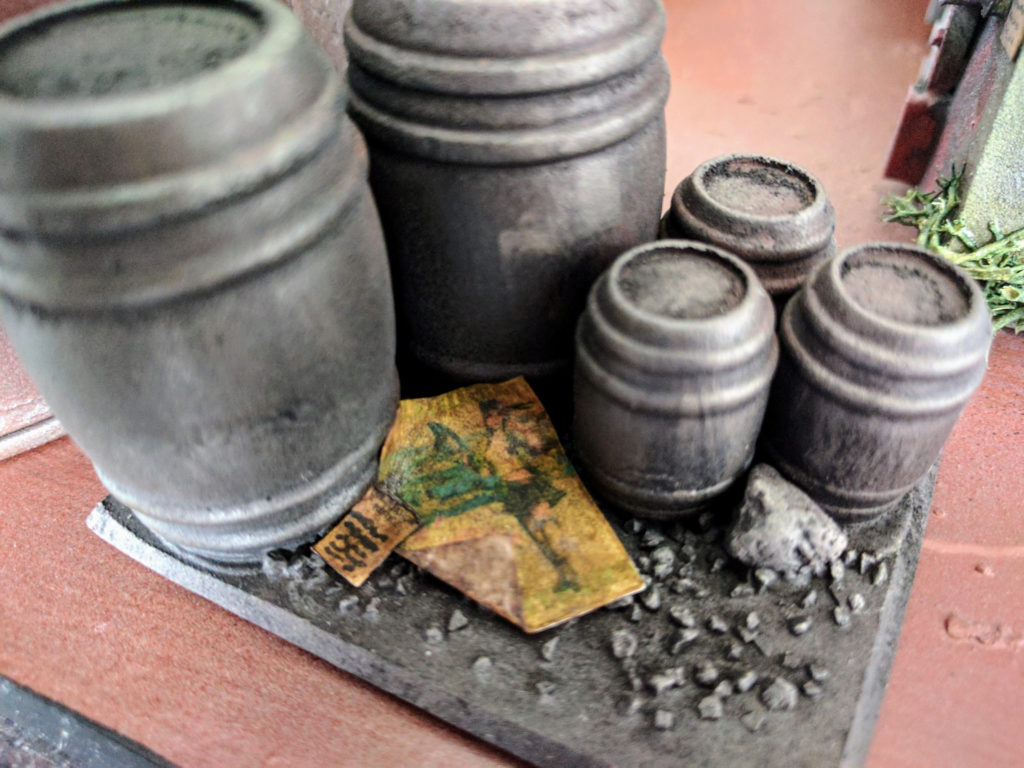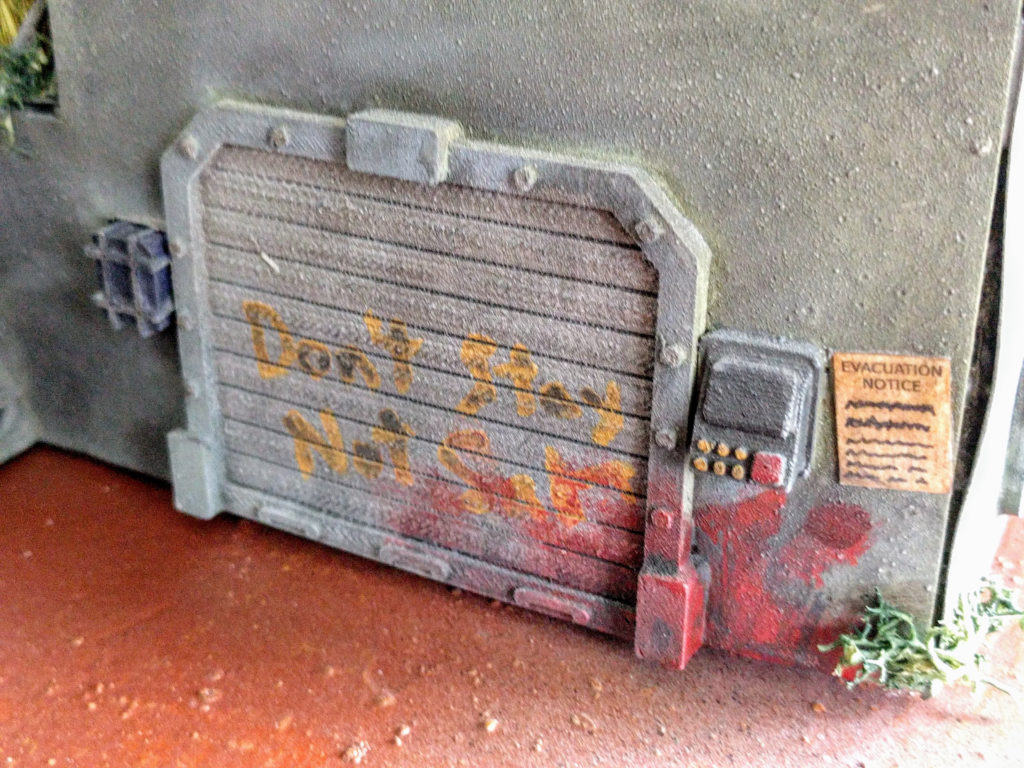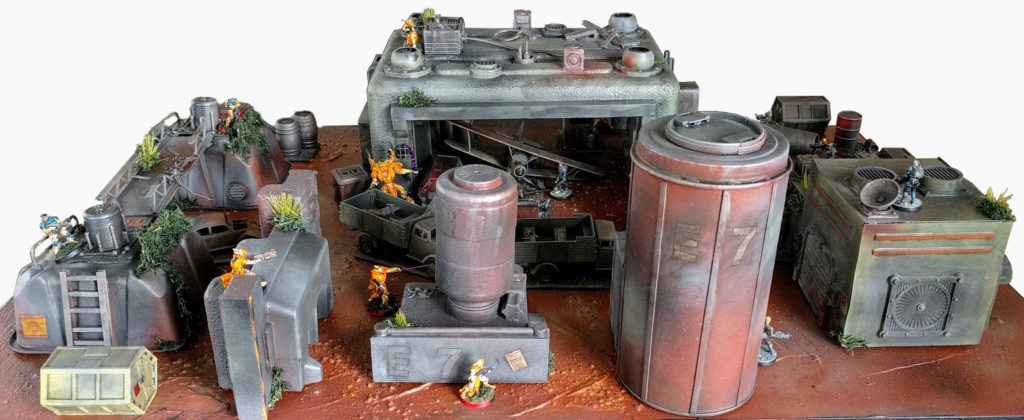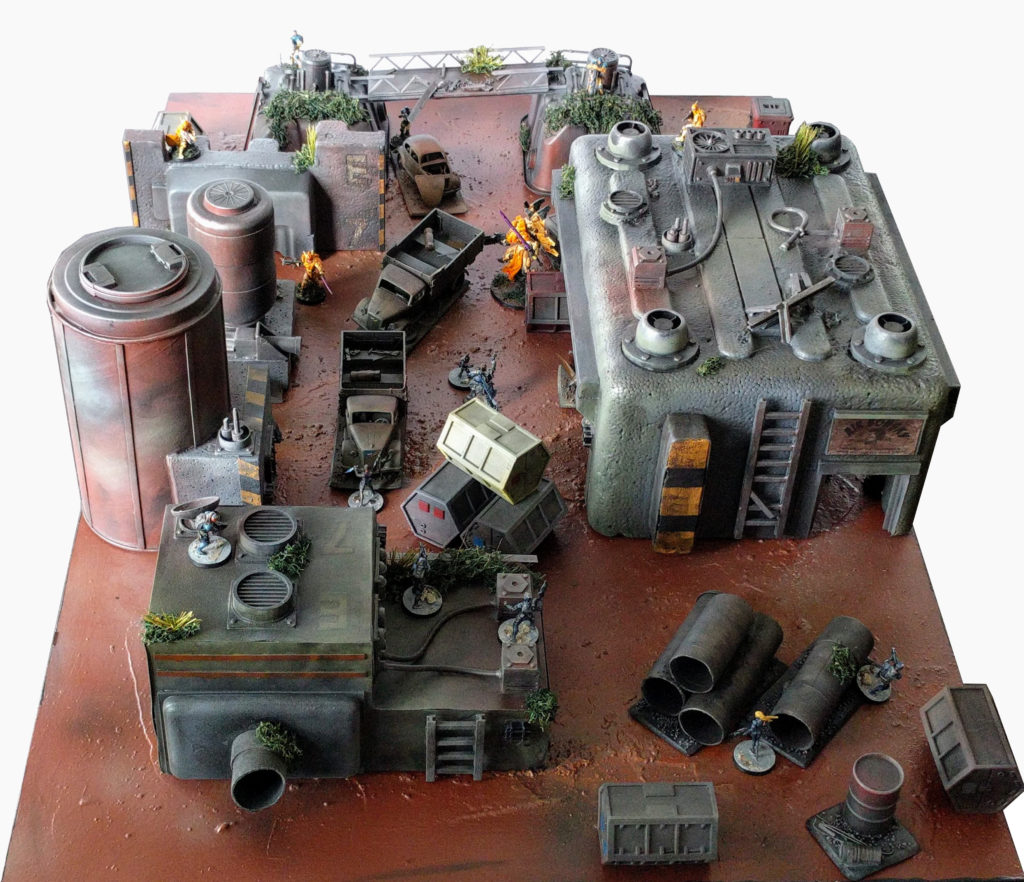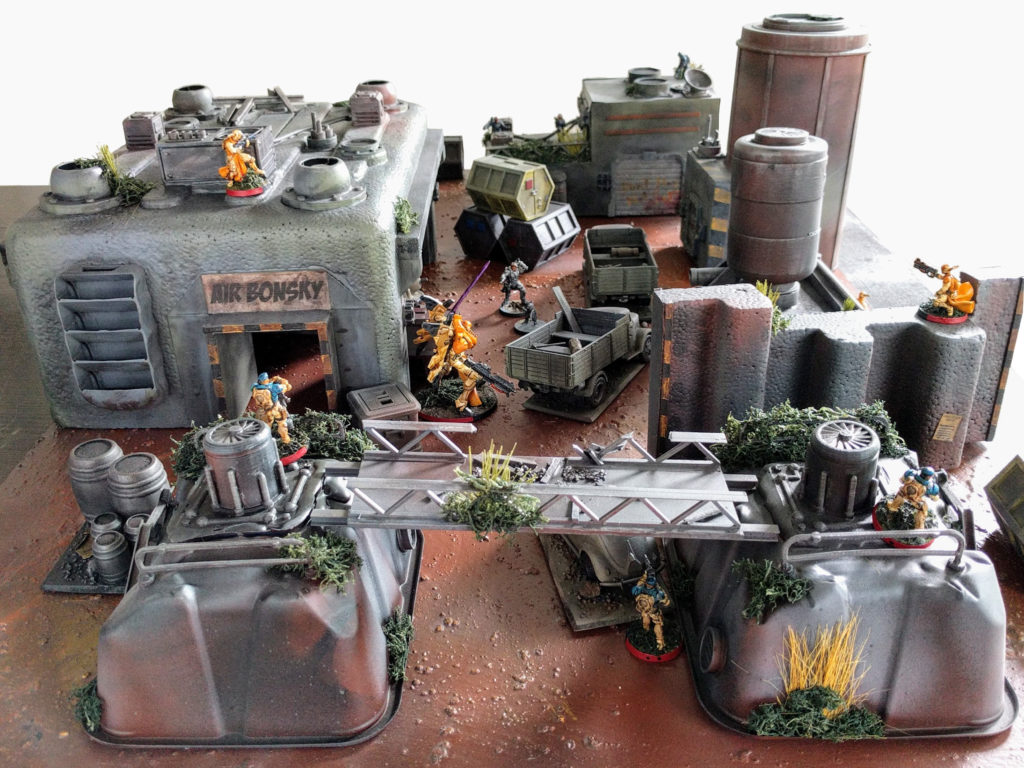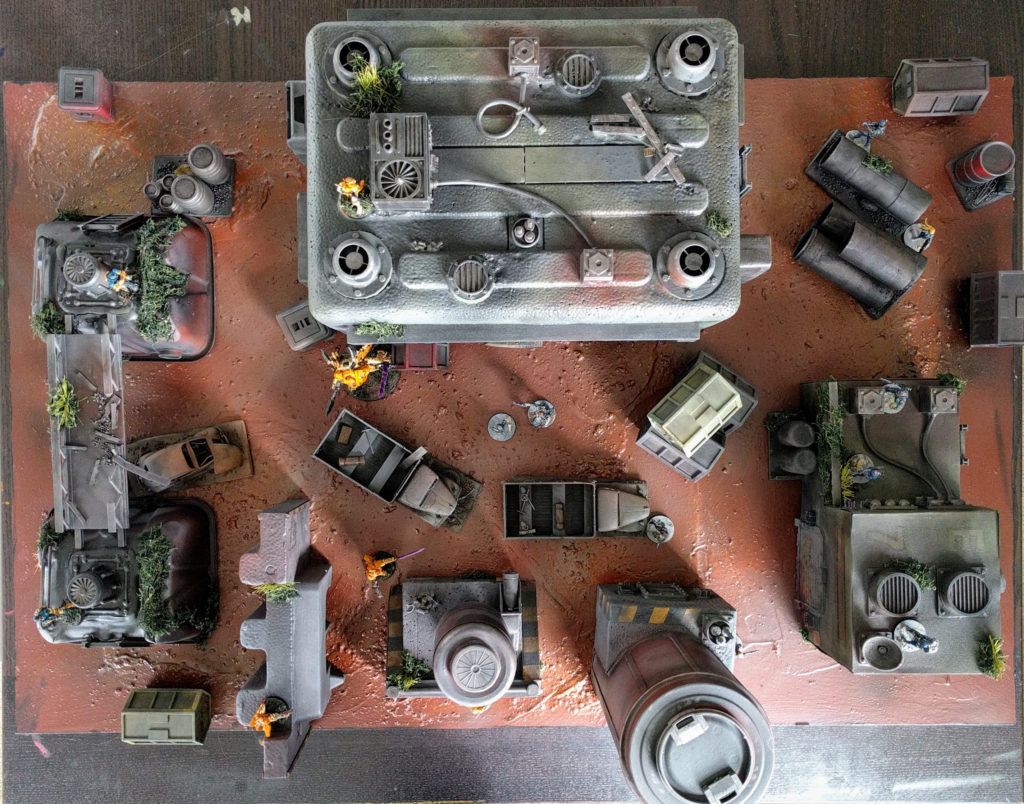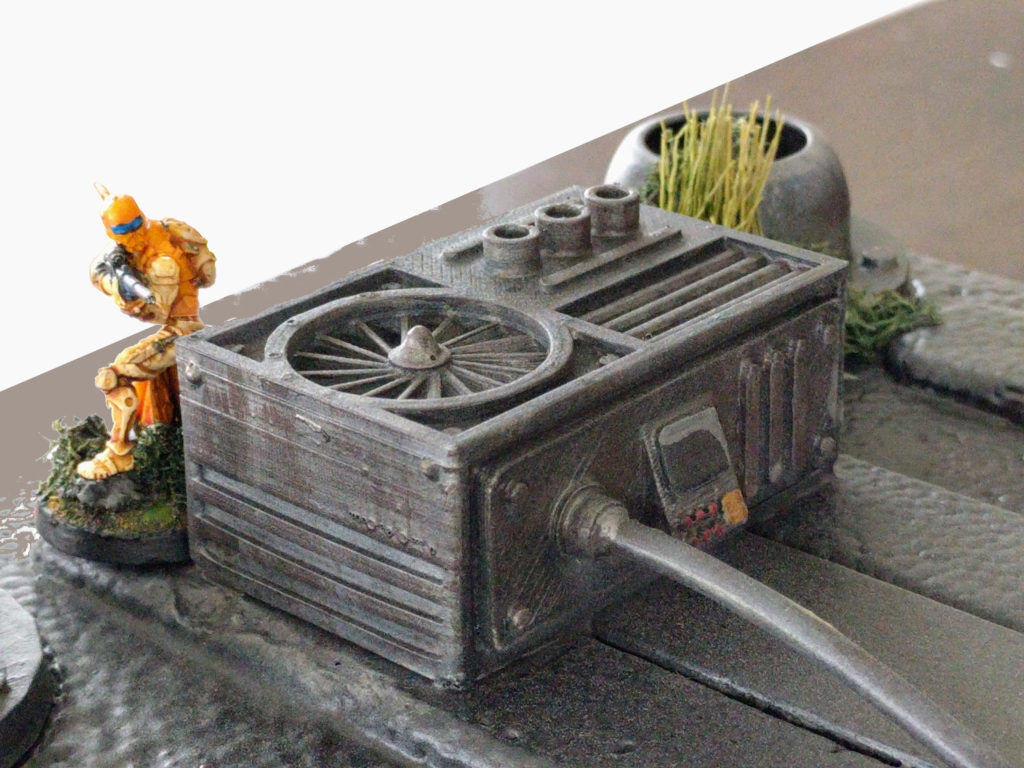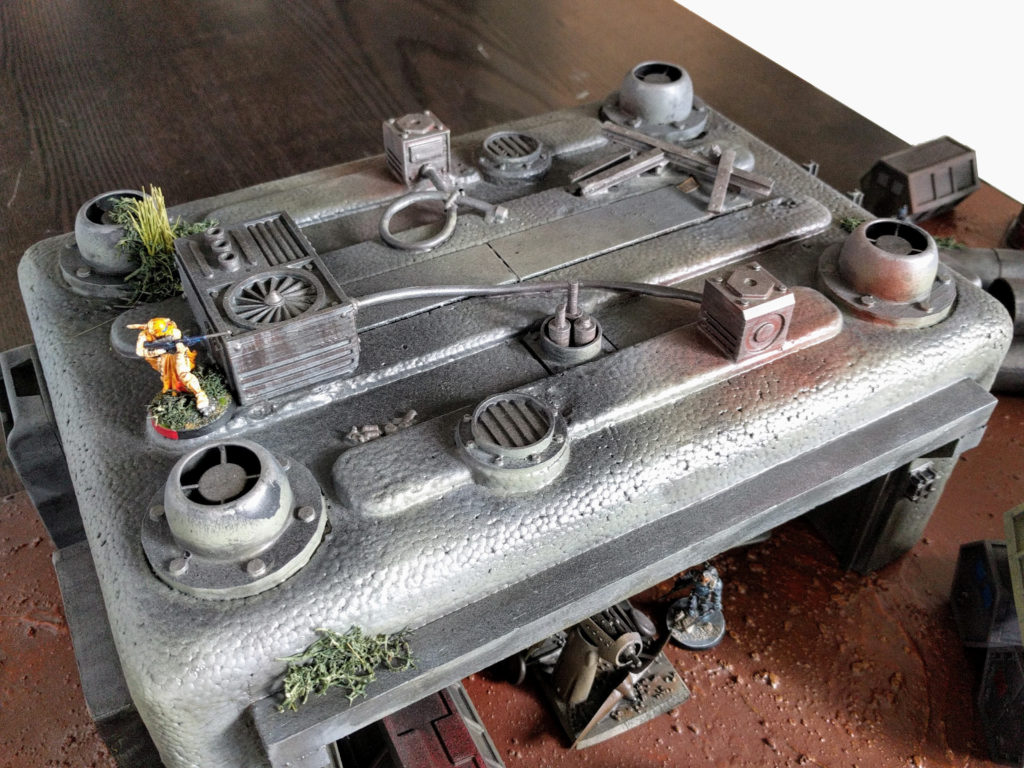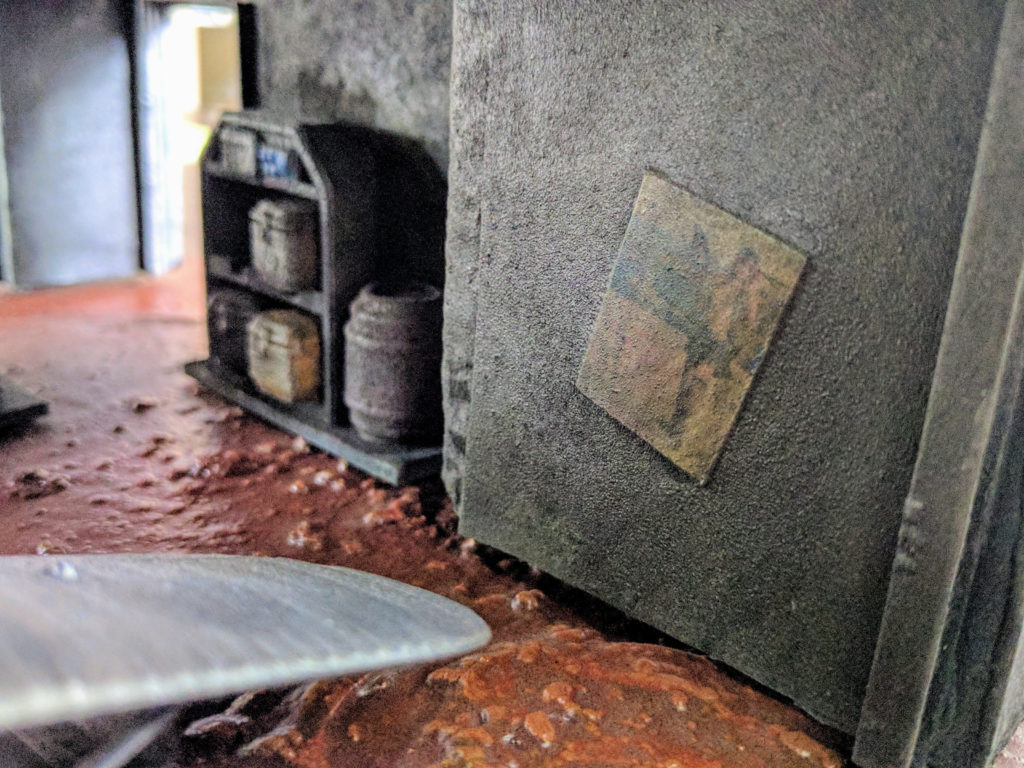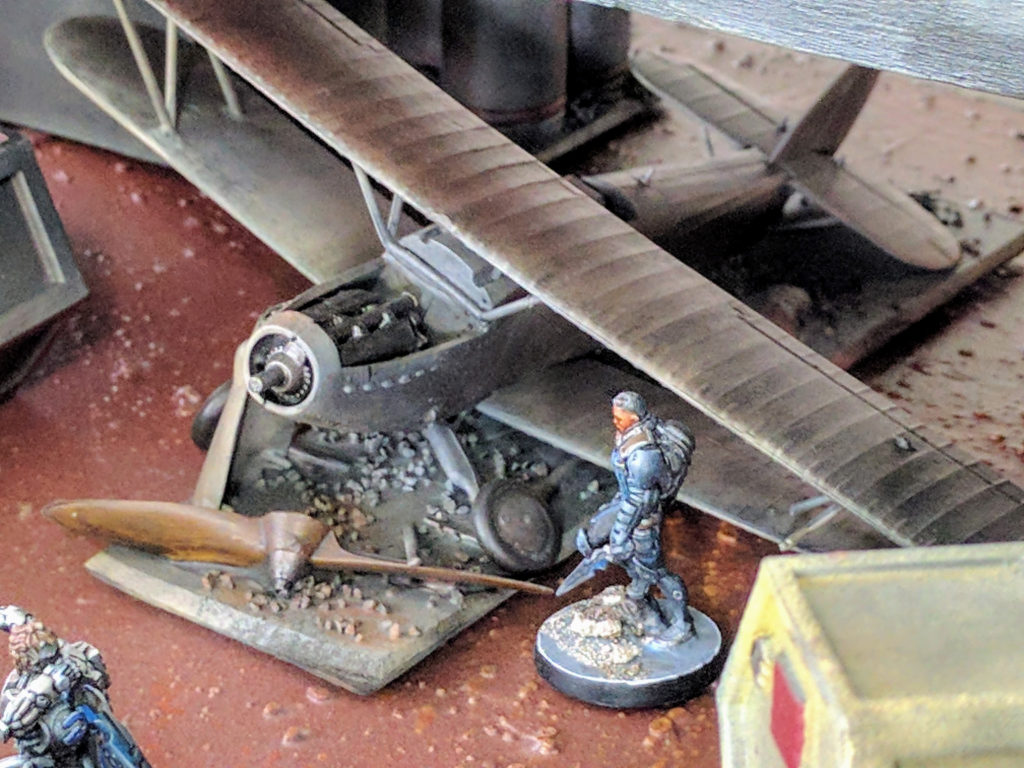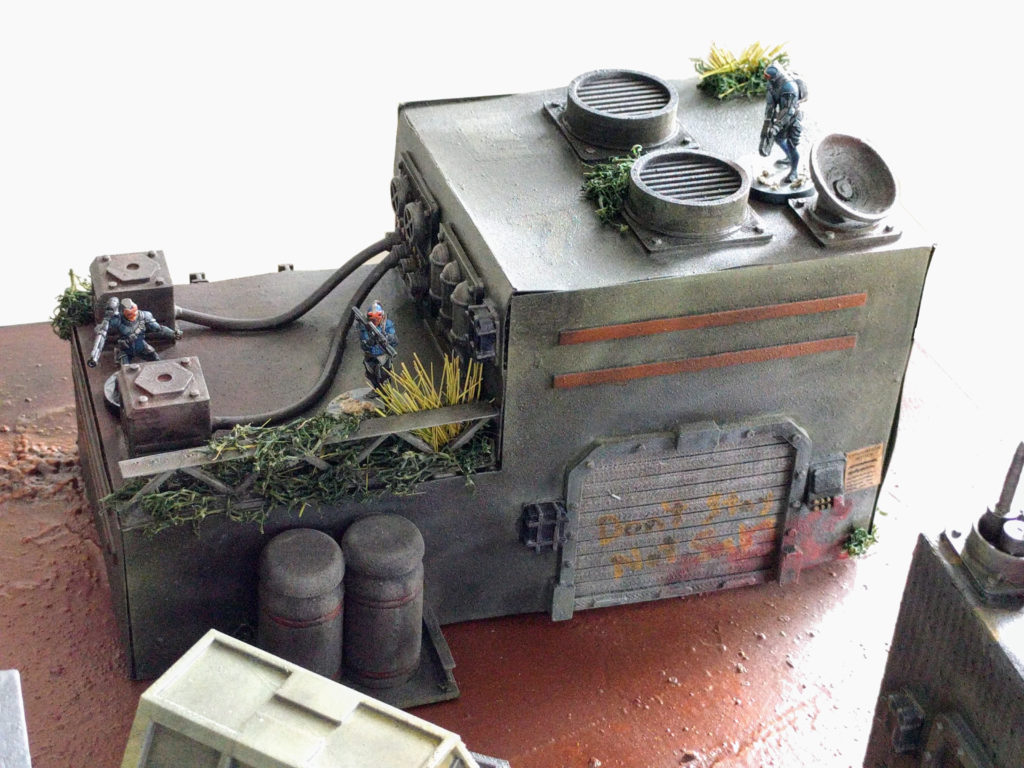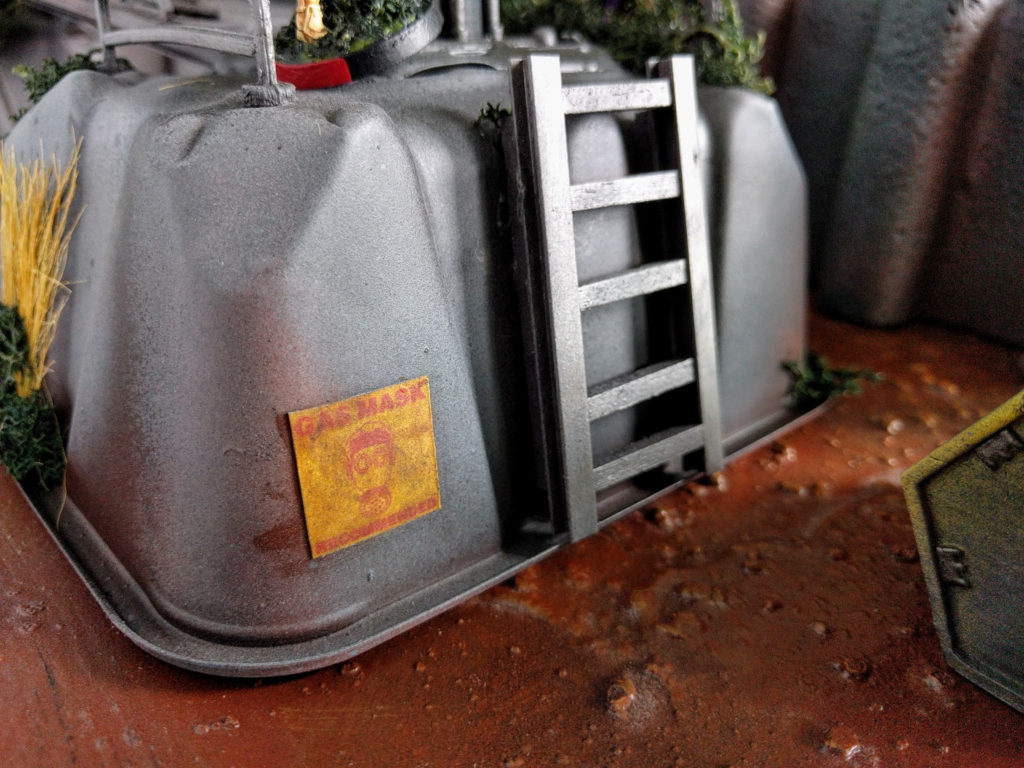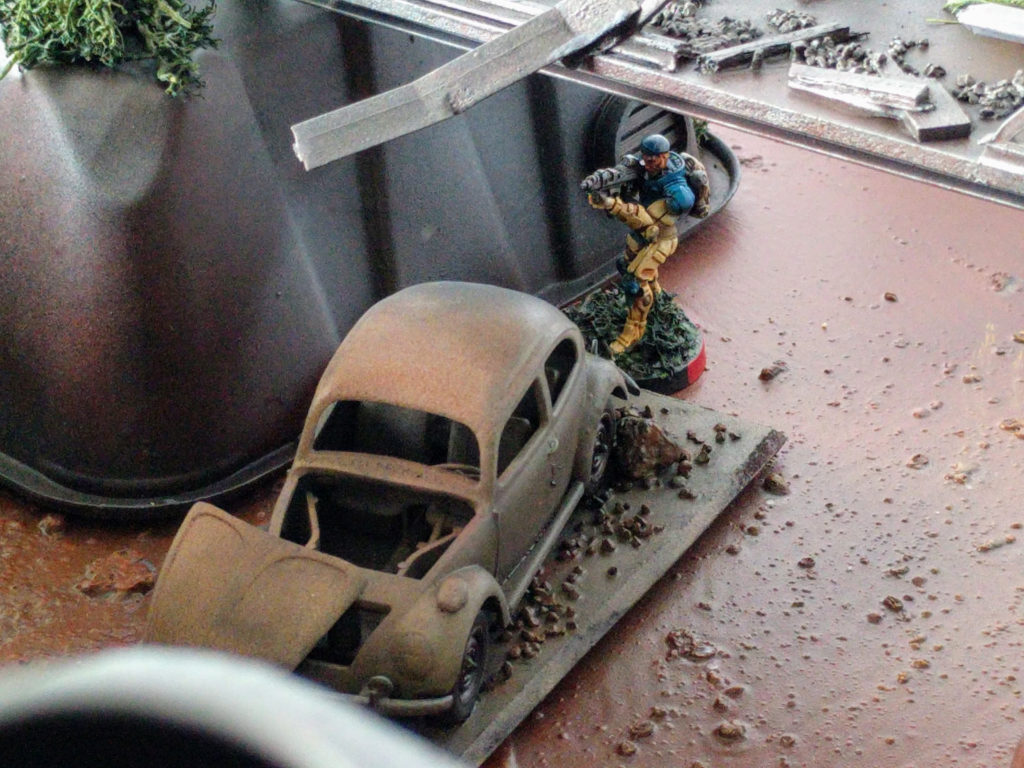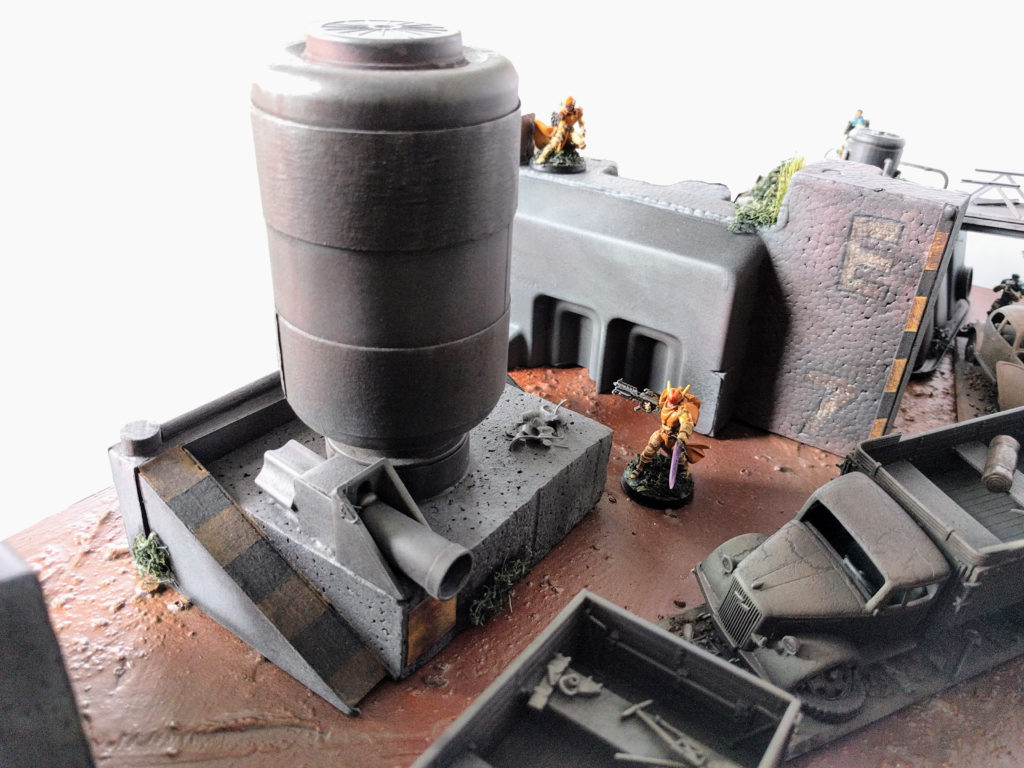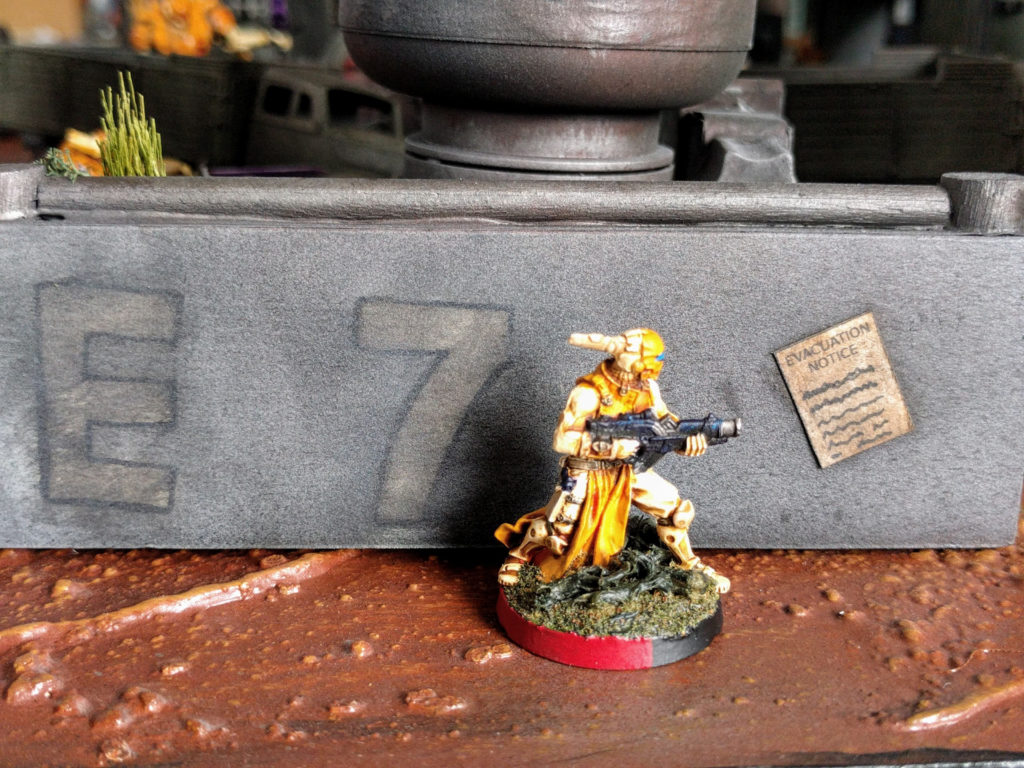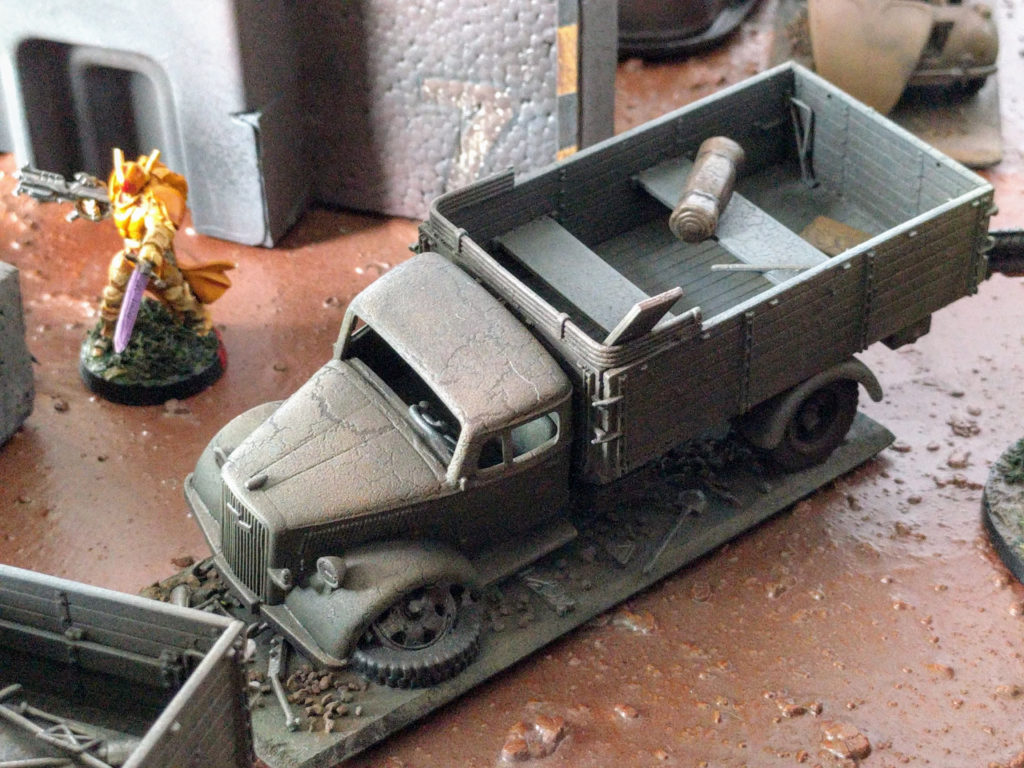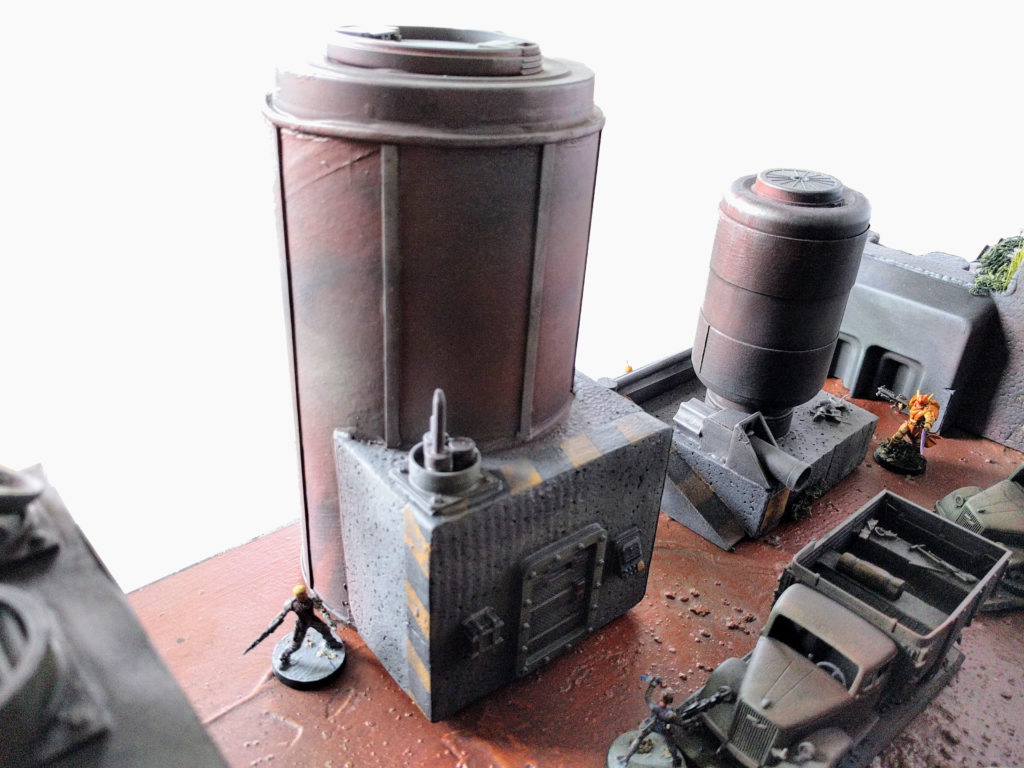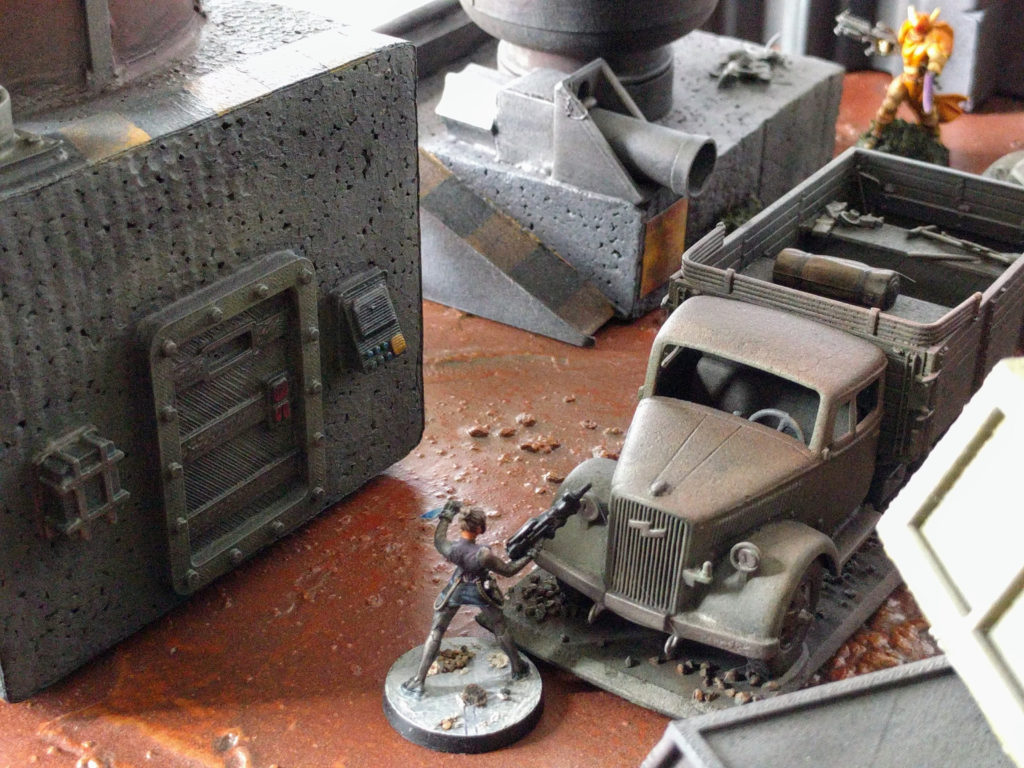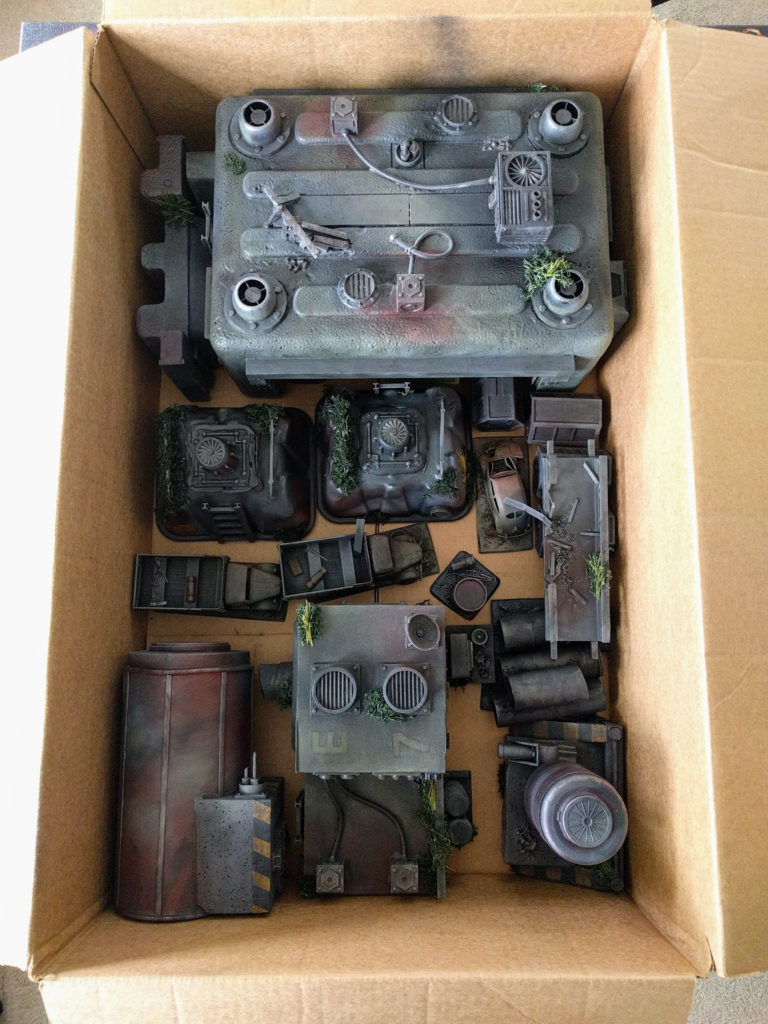Did some very very light touchup work on my Medea Refinery this past weekend: Some chipping, mostly where the gravel on the bases popped off; and regluing a ladder and two antennas. I’m very excited about how well it’s held up through a lot of play over the past ~28 months, including two NOVAs, two LibertyHammers, some smaller tournaments, and everyday play knocking around amid the public collection at Redcap’s. A testament that somewhat detailed terrain can also be robust.
Category Archives: terrain gallery
NeX-1119: Construction
Recently I finished construction of my next miniatures terrain board: NeX-1119, a secretive high-energy research facility. I’d built much of this last summer, and a few people have actually played games with some of the pieces. But the collection has lain unfinished on my shelves until I could figure out what game I was making it for and how to complete it. Now it’s all built!
In the end the board is oriented toward Infinity miniatures, but should work for other games as well. The big difference versus 40k, my other main game (along with X-Wing), is that there isn’t really any area terrain. If I’d focused it on 40k I would have mounted the smaller components on hardwood bases to create intuitive area terrain, much like many of the buildings in my Medea Refinery. It would probably also need fewer pieces. That said, there’s enough large line-of-sight blockers here that I think it’ll also work for 40k. It’ll just play differently than more typical ruins+forests+LOS boards.
At the same time, these pieces will also foster somewhat different Infinity dynamics than more typical MDF terrain. Much like my Derelict Depot, there aren’t many parapets and railings, so there’s limited ability to move on the top of the structures under partial cover. Instead you need to hop across gaps between generators, radar dishes, and so on to stay covered.
I was mindful while working to line everything up and ensure I covered at least 4 square feet, 25% of a standard 4×4 Infinity board. That’s the default density my group has largely aimed for, though recently we’ve shifted to more like 20%. In the end I built a good bit more than that, so this collection might be able to provide for two somewhat less dense tables. Certainly it can provide for multiple 2×3 RECON+ boards.
Building Modules
Much of the collection are simple constructions of electrical boxes combined with 3D printed parts for detail. Here and there some other parts crept in, like hatches from a Rhino. With the exception of a tower shown below, all of the 3D printed parts used here were designed and printed by me. Some are available on my Thingiverse profile.
These buildings have very different dynamics from typical Infinity MDF buildings in that they have much less roof area to run around on. But I think they work great as sci-fi, space-colony-module looking pieces. Several different sizes and types of electrical boxes are used, and many different kinds of bits, to create a pleasantly varied look.
A few simple scratchbuilt ladders and walkways add some vertical dimensionality, making it easier to access and move between the roofs. To further vary the overall look and heights, a large block is included on which some configuration of buildings can be placed, making them noticeably taller than the others. This also functions as a LOS blocker that covers substantial area/angles, but only for shorter figures.
Major Buildings
A few simple pieces scratchbuilt from packaging foam provide larger LOS blockers. These are not especially detailed, but have interesting enough shapes that a quick paintjob should bring them to life and look good in play. Notably, all their sides include built-in cavities or protrusions large enough for figures to tuck behind for partial cover. This reduces the amount of scatter terrain needed for the table as it’s not needed to create positions for models to leapfrog between in advancing along the longer walls.
Towers
Rounding out the buildings are several distinct towers. One is made from a laundry detergent can with a foam base and some tape wrapping to break up the shape, and an optional long ladder to reach the top. It provides the tallest location on the board. An interesting feature though is that, provided you put no scatter terrain on top, I don’t think it’s an automatic choice as a sniper location for Infinity. There’s just enough lip at the edge that a prone model won’t see anything, but nor will it get any cover if it stands to shoot. So there’s some built-in balance to its commanding height.
The other towers provide more straightforward sniper positions with partial cover, but in return are much lower. One is made from 3D printed parts custom designed to fit a canister of Gatorade powder. The other is a fully-printed piece that my friend Adam designed to fit some of my Kolony buildings. He left it behind at the shop one day and I figure he can always print more, so I’ve absorbed it into this collection.
Scatter
The last portion of the collection is a bunch of scatter terrain. There’s of course a small pile of the containers and chests in my Deployable Cargo set. New are some vaguely sci-fi looking pylons made by 3D-printing details and bases to fit a commonly used style of drink mix tablet packaging. Here I’ve used Nuun sports drink, but Airborne vitamins and other companies are also sold in this style canister. These should be interesting in that they provide good partial cover even for larger figures, and if you work the angles carefully you can move around a bit in total cover. But it’ll also be easy for an opposing figure to get an angle through the pylons to take a shot at your troops.
Painting
Despite the long gap in the middle, the actual work time for this build was fairly short. My collection of 3D-printable bits work well with these electrical boxes, and some quick scratchbuilding filled out the set. Next up is a (hopefully) quick paintjob to complete the NeX-1119 research station. I’m not sure yet what direction I’ll take that, but probably cleaner and more high-tech looking than many of my previous projects.
Derelict Depot
Battle breaks out amid the newly completed Derelict Depot!
Derelict Depot
The Derelict Depot is a board I put together for RECON+, essentially half-size games of Infinity, but it should work for a variety of skirmish games. It’s a mix of scratchbuilding, scale models, and 3D printing. More details on its creation are here:
I designed all of the 3D printed parts. Many of them are already available as free downloads in my Thingiverse collection.
The armies fighting it out here are my Military Orders and Aleph painted by Tim D.
Narrative
The story of this terrain is something like:
Early in the colonization of Ariadna, Depot E-7 was a supply outpost used by militias fighting the antipodes on the fringe of the settled area. As the border expanded outward and it was no longer militarily useful, a bold, risk-taking entrepreneur began using it as a base for an air courier service. Given the harsh conditions, limited technology, and few resources available to the colonists, its equipment was all based on very old and simple technology easy to construct and maintain. The service provided an important link ferrying supplies, messages, and people over the dangerous ground between the new, far flung settlements popping up as the colony grew rapidly. Later though the depot was overrun as its region collapsed in one of the periodic waves of antipode fighting. Although abandoned since then, it has recently come to be occasionally used as a waypoint or temporary base by various special forces teams operating on Ariadna.
The board is of course designed overall to feel abandoned and disused, but particulars of that story are captured in details here and there: Signage declares the garage to be the home of the “Air Bonsky” courier service (Bonsky being our local lead Infinity TO); militia recruitment and “EVACUATION NOTICE” posters are scattered about on some of the walls and littered on the floor; blood spatters mark where the last defender was caught when the base was overrun; a walkway has been twisted and burnt by high explosives in more recent fighting. It’s not much of a story, but it was just enough to generate some unique, cohesive imagined micro-vignettes and details to add flavor.
Play
This board is definitely designed with just a bit of priority toward aesthetics and narrative versus gameplay. In a few places it can be a touch awkward to place figures because of details, many of the shapes are slightly odd so models often don’t perfectly snug up into cover, and so on. But it’s very playable, and has interesting features.
As one example, none of the buildings have the ubiquitous low walls found on almost all Infinity MDF terrain. In places where railings make real-world sense and cover would be useful for gameplay, the metalwork is more realistically thin and open, but overgrown in thick vegetation to physically obscure models and leave no doubt they’re intended to be cover. In other places, a variety of mechanical boxes, large vent outlets, and other details scattered about provide partial cover instead of walls and screens. This approach creates some interesting dynamics. For example, the top of the garage can be a great vantage point for controlling ground below. But it’s essentially not possible to move around on it without either breaking cover between features or going prone out of sight and foregoing your own shooting, quite different from moving along a rooftop railing or edge. At the same time, it’s not possible to get cover from all angles, so no sniper can rest easy if there’s a chance the enemy can flank them—which they might very well do by running through the garage directly underneath them!
Similarly, the tallest point, the silo, has a piece on top such that models can generally only be placed solidly at the very center. A small lip prevents models from fitting at the edge. So a sniper can be placed there for a commanding view, but if they go prone they won’t be able to shoot anything, and if they stand up they won’t get cover.
The board as shown here is very dense, which impacts some armies negatively, but that just means there’s plenty of pieces to be used or not used in different games, generating a lot of variety in potential setups.
Next!
I’m very happy with how the Derelict Depot came together. It was a nice, tractable effort that didn’t drag on forever, and got done on schedule—just barely!—for an event I wanted to use it in. My small library of 3D printable parts made expressly to quickly add details to scratchbuilt terrain like this provided plenty of variety and interesting features, and I enjoyed making good use of a number of found objects. People seem to enjoy playing on the board, the pieces have some neat game dynamics, and the terrain has a lot of character and cool visuals. Mission accomplished!
For another example of this kind of scratchbuilding + scale models + 3D printing, check out my Medea Refinery build. Partly by chance and partly by design, pieces from the two sets go together well to create a really cool, large, detailed board. I also have a few tutorials up on 3D printing and modeling.
I’m not sure quite when I’ll get to them with NOVA and other events coming up, but I’m kicking around a couple neat ideas for new boards and in some cases have even started some work. Stay tuned!
